Search Result
Results for "
active substrate
" in MedChemExpress (MCE) Product Catalog:
4
Biochemical Assay Reagents
2
Isotope-Labeled Compounds
| Cat. No. |
Product Name |
Target |
Research Areas |
Chemical Structure |
-
- HY-W012145
-
|
|
Others
|
Metabolic Disease
|
|
TMPD dihydrochloride, a readily oxidizable compound, is an enzymatically convert redox active substrate molecule. TMPD dihydrochloride is also an electron donor and serves as a reducing cosubstrate for heme peroxidases . TMPD dihydrochloride is also a complex IV substrate .
|
-
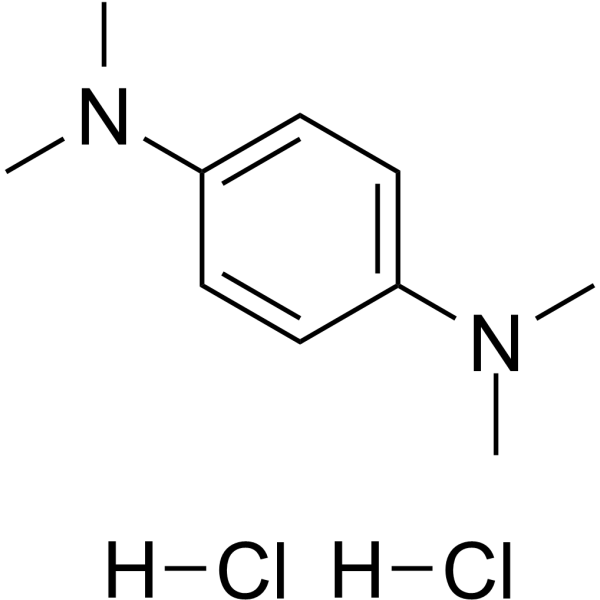
-
- HY-N7263
-
|
|
Cholinesterase (ChE)
|
Neurological Disease
|
|
Galanthamine N-Oxide is an alkaloid obtained from the bulbs of Zephyranthes concolor. Galanthamine N-Oxide inhibits electric eel acetylcholinesterase (AChE) with an EC50 of 26.2 μM. Galanthamine N-Oxide is a prominent inhibitor of substrate accommodation in the active site of the Torpedo californica AChE (TcAChE), hAChE and hBChE enzymes .
|
-
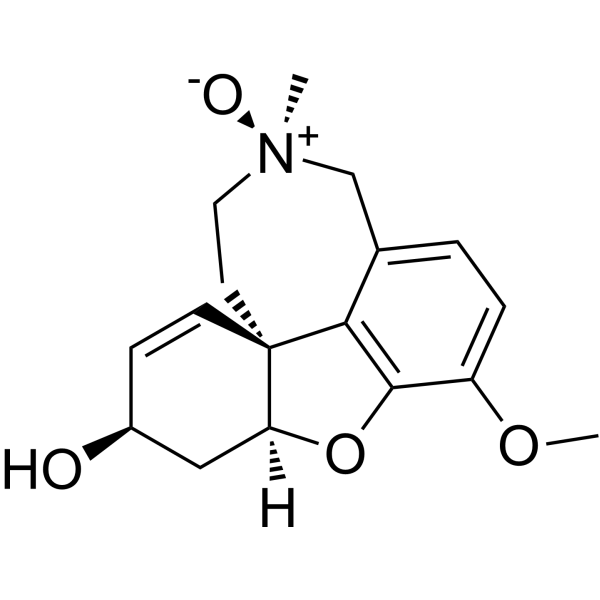
-
- HY-D1686B
-
|
|
DNA Stain
|
Others
|
|
Biotin-16-UTP tetrasodium is an active substrate for RNA polymerase. Biotin-16-UTP tetrasodium can replace UTP in the in vitro transcription reaction for RNA labeling .
|
-
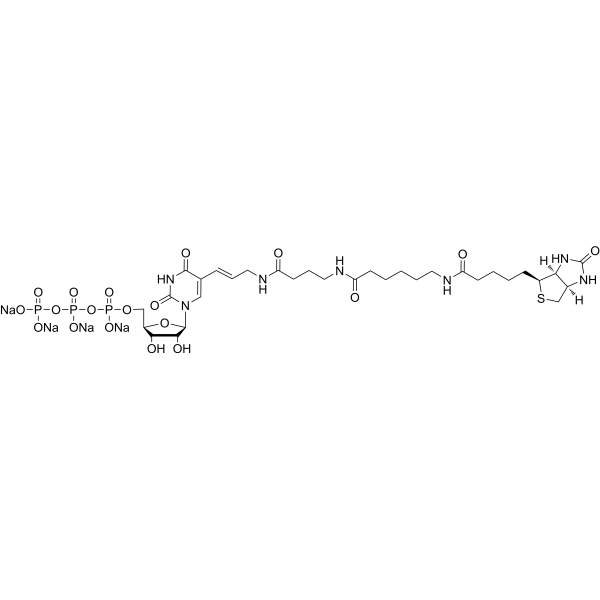
-
- HY-134423
-
|
Stearoyl-CoA lithium
|
Biochemical Assay Reagents
|
Others
|
|
Stearoyl coenzyme A (Stearoyl-CoA) lithium is an active compound that can be used as a substrate for the determination of stearoyl-Coenzyme desaturase in microsomes .
|
-
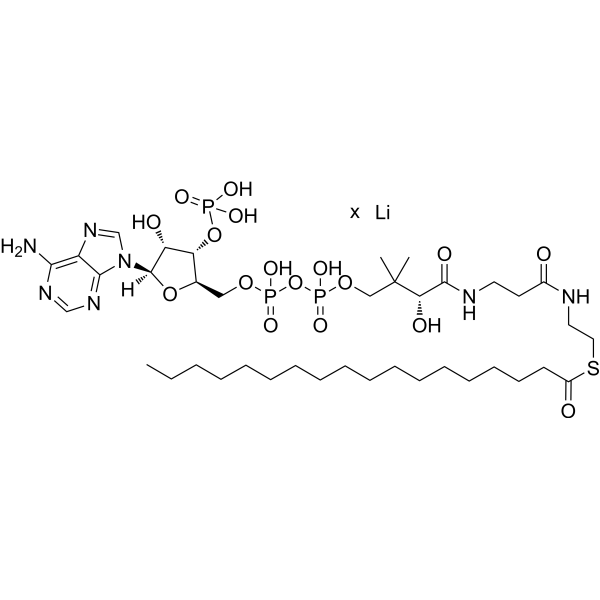
-
- HY-D1686
-
|
|
DNA Stain
|
Others
|
|
Biotin-16-UTP is an active substrate for RNA polymerase. Biotin-16-UTP can replace UTP in the in vitro transcription reaction for RNA labeling .
|
-
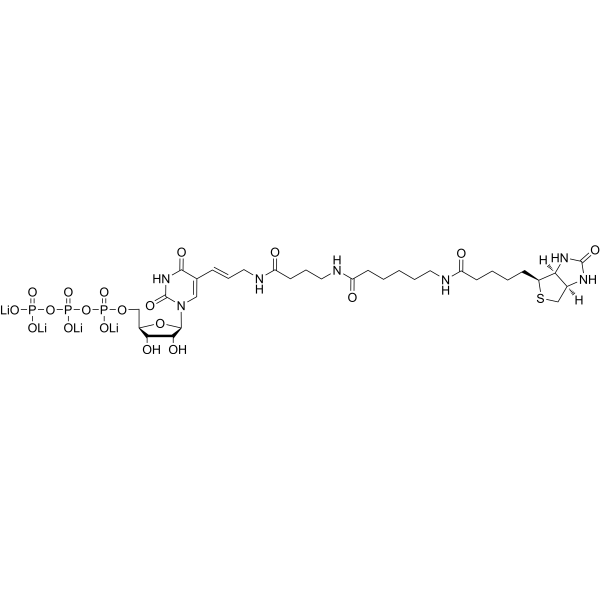
-
- HY-119101
-
|
|
CCR
Potassium Channel
P-glycoprotein
|
Inflammation/Immunology
|
|
AZD-5672 is an orally active, potent, and selective CCR5 antagonist (IC50=0.32 nM). AZD-5672 shows moderate activity against the hERG ion channel (binding IC50=7.3 μM). AZD5672 is a substrate of human P-gp, and inhibits P-gp-mediated digoxin transport (IC50=32 μM). AZD-5672 can be used for the research of rheumatoid arthritis .
|
-

-
- HY-P0320
-
|
|
Phosphatase
|
Others
|
|
EGF Receptor Substrate 2 (Phospho-Tyr5) acetate, a biologically active peptide, is a tyrosine phosphate substrate. EGF Receptor Substrate 2 (Phospho-Tyr5) acetate can be used to detect protein tyrosine phosphatases activity .
|
-
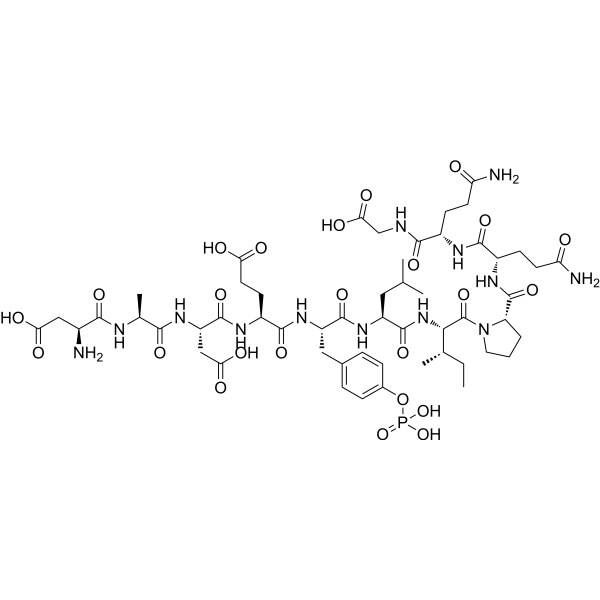
-
- HY-P0320A
-
|
|
Phosphatase
Biochemical Assay Reagents
|
Others
|
|
EGF Receptor Substrate 2 (Phospho-Tyr5) acetate, a biologically active peptide, is a tyrosine phosphate substrate. EGF Receptor Substrate 2 (Phospho-Tyr5) acetate can be used to detect protein tyrosine phosphatases activity .
|
-
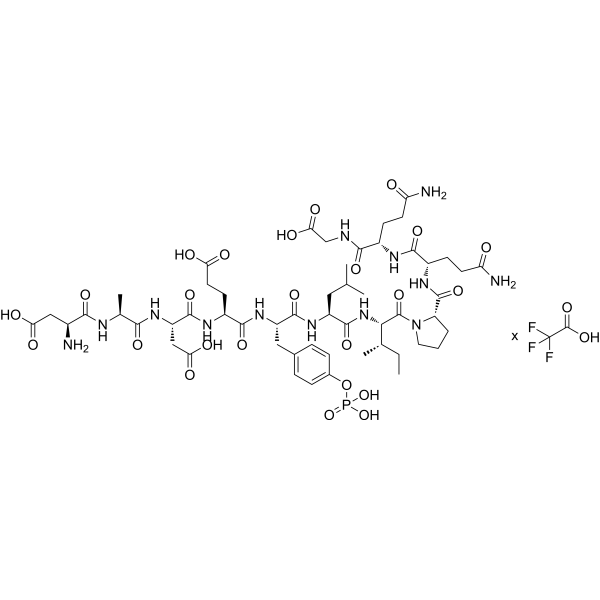
-
- HY-P0320B
-
|
|
Phosphatase
Biochemical Assay Reagents
|
Others
|
|
EGF Receptor Substrate 2 (Phospho-Tyr5) acetate, a biologically active peptide, is a tyrosine phosphate substrate. EGF Receptor Substrate 2 (Phospho-Tyr5) acetate can be used to detect protein tyrosine phosphatases activity .
|
-
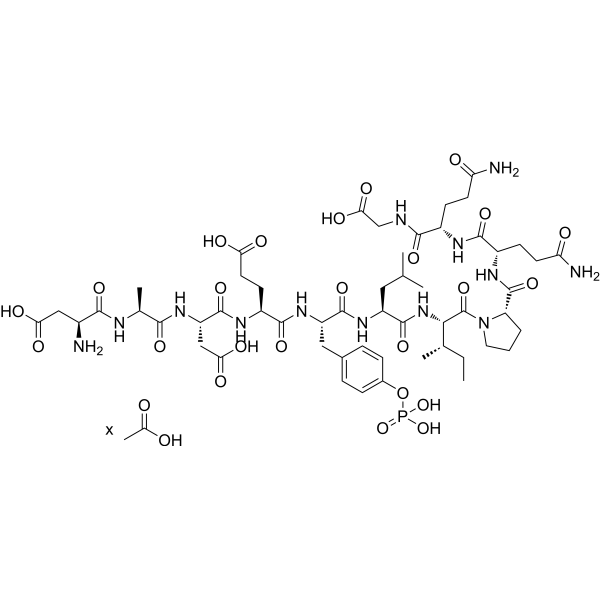
-
- HY-P5450
-
|
|
PDK-1
|
Others
|
|
PDKtide is a biological active peptide. (This peptide is a substrate for PDK1 (Phosphatidylinositide-Dependent Kinase 1).)
|
-

-
- HY-P1906
-
|
|
CDK
|
Neurological Disease
|
|
[pThr3]-CDK5 Substrate is an effective Phospho-Thr3CDK5 Substrate. [pThr3]-CDK5 Substrate is derived from the sequence of the histone H1 peptide that docks in the active site of CDK5. [pThr3]-CDK5 Substrate is phosphorylated by CDK5 with a Km value of 6 µM .
|
-
![[pThr3]-CDK5 Substrate](//file.medchemexpress.com/product_pic/hy-p1906.gif)
-
- HY-P1906A
-
|
|
CDK
|
Neurological Disease
|
|
[pThr3]-CDK5 Substrate TFA is an effective Phospho-Thr3CDK5 Substrate. [pThr3]-CDK5 Substrate is derived from the sequence of the histone H1 peptide that docks in the active site of CDK5. [pThr3]-CDK5 Substrate is phosphorylated by CDK5 with a Km value of 6 µM .
|
-
![[pThr3]-CDK5 Substrate TFA](//file.medchemexpress.com/product_pic/hy-p1906a.gif)
-
- HY-P5383
-
|
|
MMP
|
Others
|
|
Mca-Pro-Leu-Gly-Leu-Dap(Dnp)-Ala-Arg-NH2 is a biological active peptide. (MMP substrate)
|
-
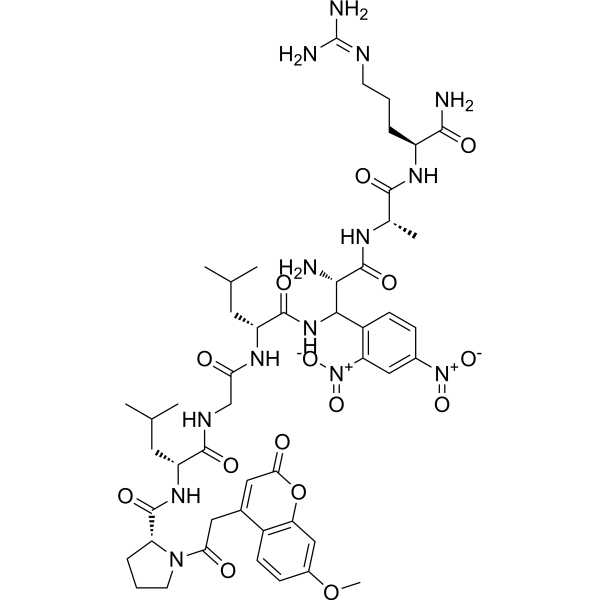
-
- HY-114599
-
|
|
Endogenous Metabolite
|
Others
|
|
8-iso Prostaglandin A1 is an active substrate for Arabidopsis thaliana OPR3 (AtOPR3), with a KM of 22 μM .
|
-
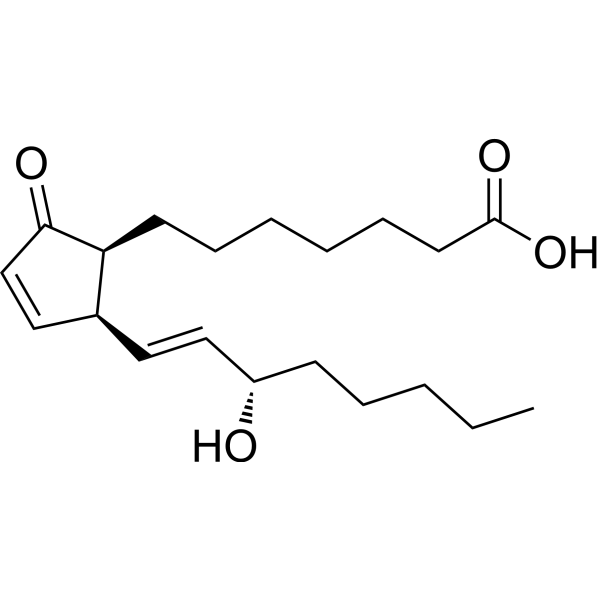
-
- HY-P2716
-
|
|
MMP
|
Others
|
|
Mca-Arg-Pro-Lys-Pro-Tyr-Ala-Nva-Trp-Met-Lys(Dnp)-NH2 is a biological active peptide. (MMP substrate)
|
-
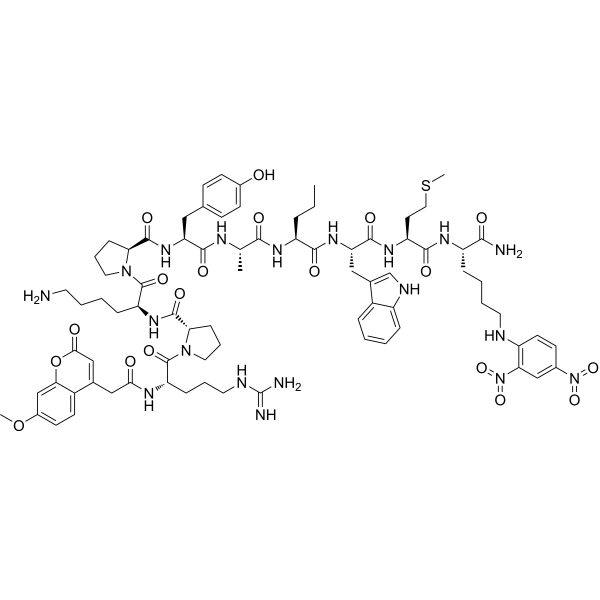
-
- HY-153859
-
|
|
Others
|
Others
|
|
Ser-SNAC TFA is a small-molecule substrate for NRPS C domains. As for NRPSs, refers to nonribosomal peptide synthetases, are large multidomain proteins to catalyze the formation of biologically active natural products. Ser-SNAC TFA can be used for characterizing the substrate specificity of C domain-catalyzed peptide bond formation .
|
-
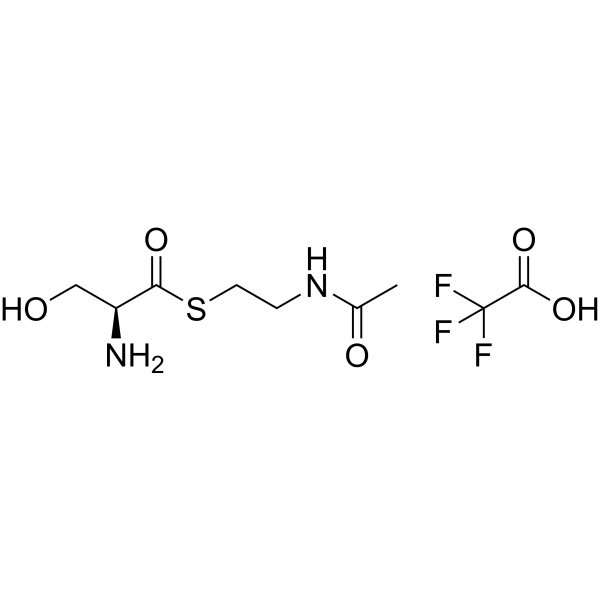
-
- HY-134421
-
|
|
Biochemical Assay Reagents
|
Others
|
|
2-Butenoyl coenzyme A (lithium), an active compound, can be used as a substrate for plasmodium falciparum enyl-ACP reductases and other enyl-CoA reductases. 2-Butenoyl coenzyme A lithium can be used as a substrate analogue to study the kinetics of β-hydroxyacyl-acyl-carrier protein (ACP) dehydratase (FabZ) .
|
-
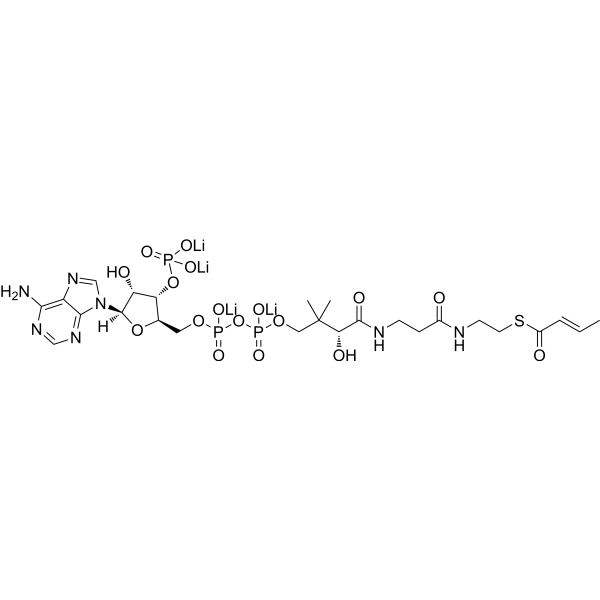
-
- HY-A0279A
-
|
Mikamycin B; Mikamycin IA
|
Bacterial
Antibiotic
|
Infection
|
|
Pristinamycin IA (Mikamycin B) is a cycle-peptidic macrolactone antibiotic. Pristinamycin IA is a substrate of P-glycoprotein and inhibits its function. Pristinamycin IA is active against StaphyloEoccus and Srreptococcus .
|
-
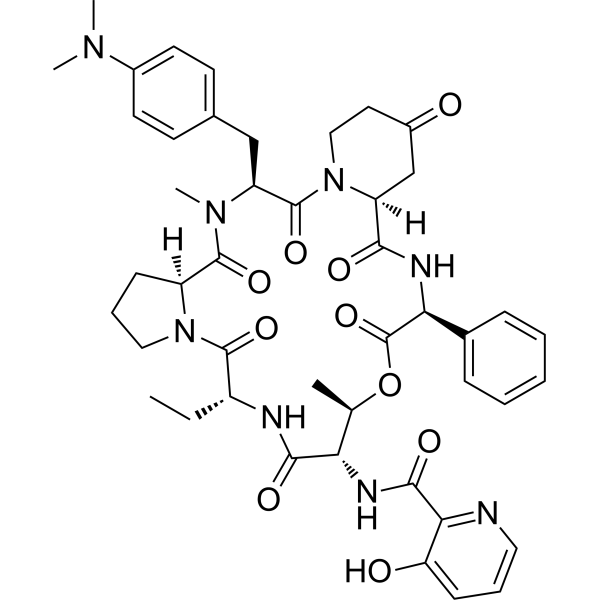
-
- HY-148150
-
|
|
Others
|
Cancer
|
|
Cyclocreatine phosphate is an anti-tumor agent. Cyclocreatine phosphate is the proposed active form of cyclocreatine (CCr), a substrate analogue of creatine kinase. Cyclocreatine phosphate has anti-tumour activity and can be used for the research of cancer .
|
-
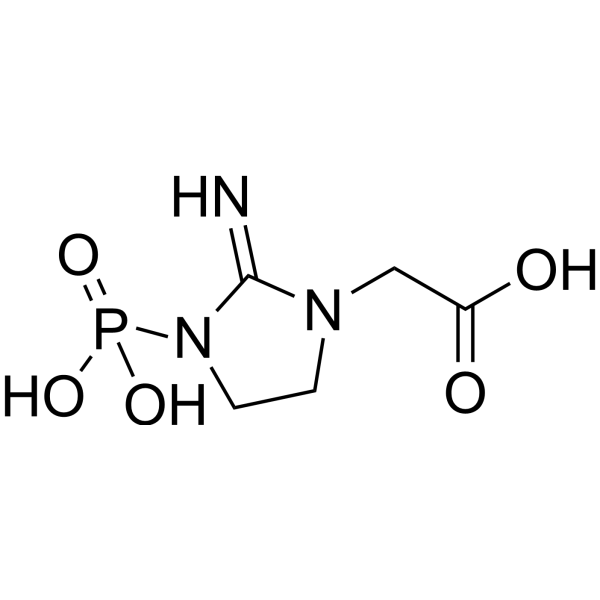
-
- HY-P5440
-
|
|
ERK
|
Others
|
|
ERKtide is a biological active peptide. (ERKtide is a peptide substrate for ERK2. Extracellular regulated protein kinase 2 (ERK2) is a eukaryotic protein kinase whose activity is regulated by mitogenic stimuli.)
|
-
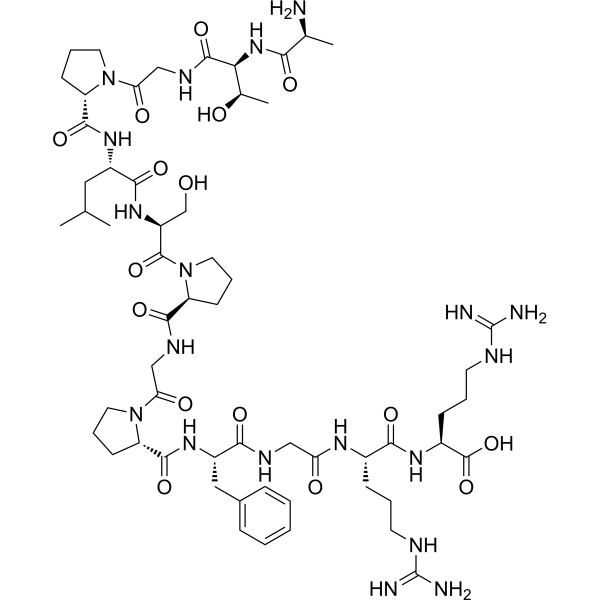
-
- HY-P3476
-
|
|
CRISPR/Cas9
|
Cancer
|
|
Mca-VDQVDGW-Lys(Dnp)-NH2 is a fluorogenic substrate of caspase-7. Mca-VDQVDGW-K(Dnp)-NH2 can be used to quantify caspase-7 activity.
|
-
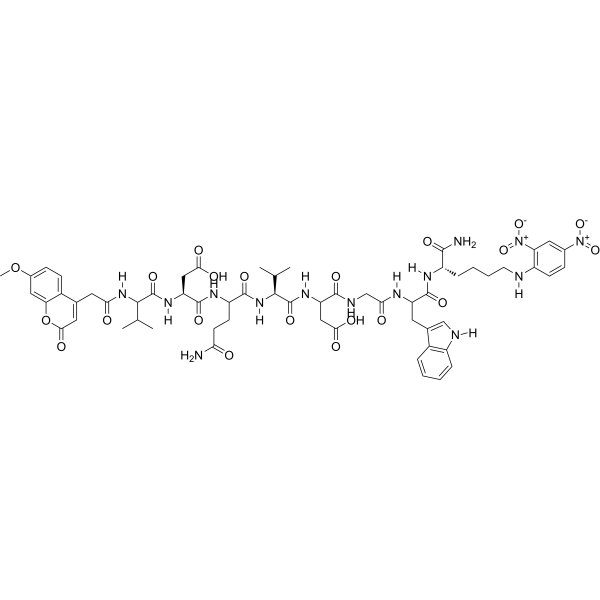
-
- HY-P3477
-
|
|
Fluorescent Dye
|
Others
|
|
Mca-PLA-Nva-Dap(Dnp)-AR-NH2 is a fluorogenic substrate for matrix metalloproteinase-2 (MMP-2) .
|
-
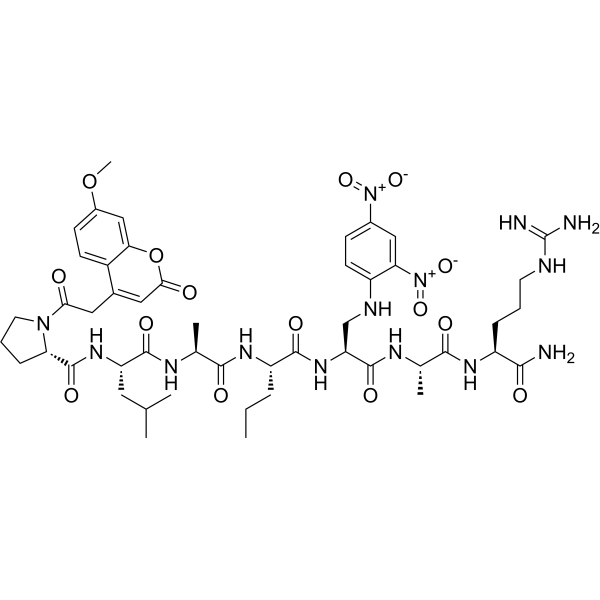
-
- HY-P3699
-
|
|
Fluorescent Dye
|
Others
|
|
TNO003 is a selective fluorogenic substrate. TNO003 can be used for the research of various biochemical .
|
-

-
- HY-105124A
-
|
Ro 3-4787 hydrochloride
|
Adrenergic Receptor
|
Cardiovascular Disease
Endocrinology
|
|
Bufuralol (Ro 3-4787) hydrochloride is a potent non-selective, orally active β-adrenoreceptor antagonist with partial agonist activity. Bufuralol hydrochloride is a CYP2D6 probe substrate .
|
-
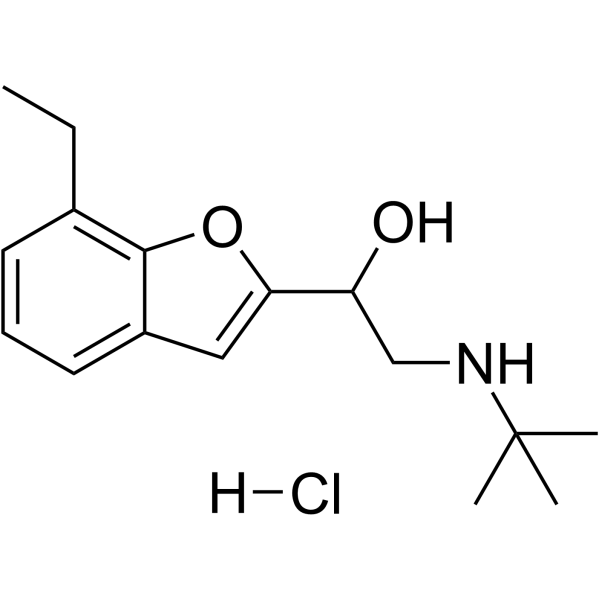
-
- HY-105124
-
-

-
- HY-B1190A
-
|
BL-S 578 hydrate
|
|
|
|
Cefadroxil hydrate (BL-S 578 hydrate) is an orally active and first-generation cephalosporin with a broad spectrum antibacterial activity. Cefadroxil hydrate (BL-S 578 hydrate) also acts as a substrate of the peptide transporter PEPT1 and PEPT2 .
|
-
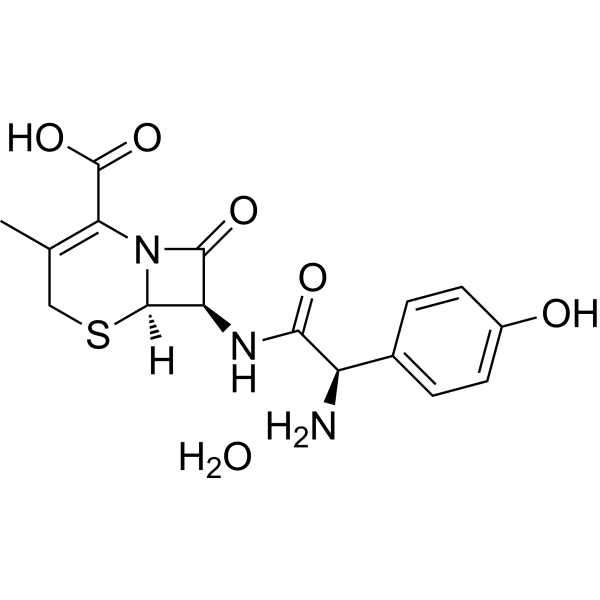
-
- HY-16137
-
|
Cephaloglycin
|
Bacterial
|
Infection
|
|
Cefaloglycin (Cephaloglycin) is an orally active nephrotoxic β-lactam cephalosporin antibiotic with antibacterial activity. Cefaloglycin is activity against Gram-Positive cocci other than enterococci. Cefaloglycin is toxic to mitochondrial substrate uptake and respiration .
|
-
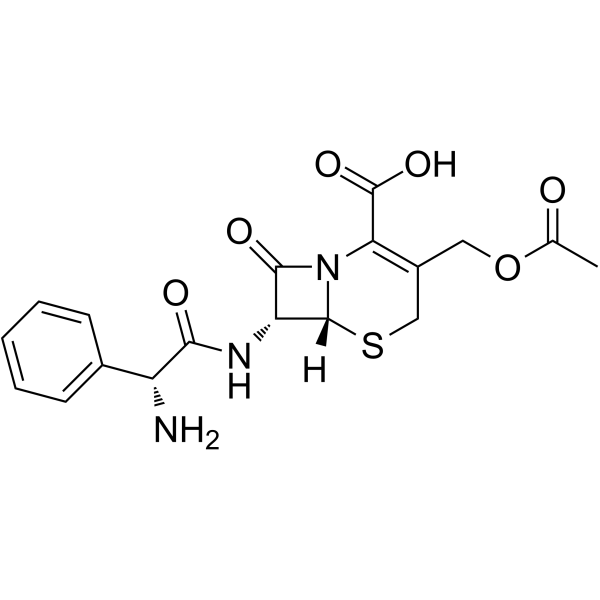
-
- HY-122661
-
|
MPH
|
PARP
Apoptosis
|
Cancer
|
|
Mefuparib hydrochloride (MPH) is an orally active, substrate-competitive and selective PARP1/2 inhibitor with IC50s of 3.2 nM and 1.9 nM, respectively. Mefuparib hydrochloride induces apoptosis and possesses prominent anticancer activity in vitro and in vivo .
|
-
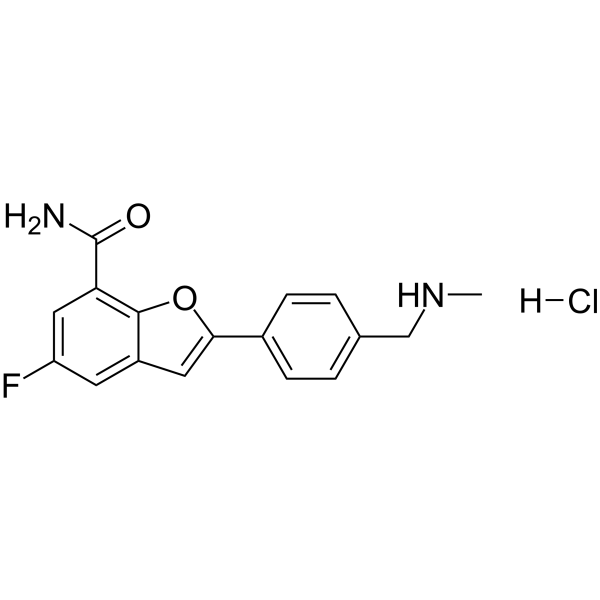
-
- HY-116750
-
|
|
Tyrosinase
|
Others
|
|
6-Hydroxykaempferol, a flavonoid, is a competitive tyrosinase inhibitor with an IC50 value of 124 μM. 6-Hydroxykaempferol has a Ki value of 148 μM relative to L-DOPA as a substrate and effectively inhibits the activity of the enzyme by binding to the active site of the enzyme .
|
-
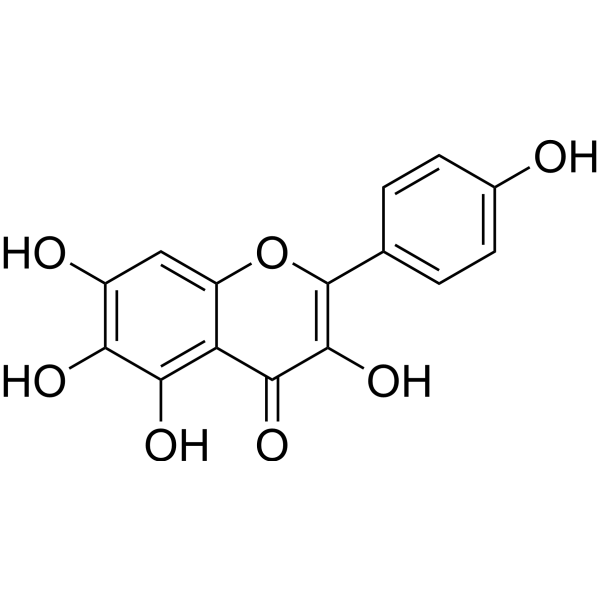
-
- HY-134423S
-
|
|
Isotope-Labeled Compounds
|
Others
|
|
Stearoyl coenzyme A- 13C18 (lithium) is the 13C labeled Stearoyl coenzyme A lithium[1]. Stearoyl coenzyme A (Stearoyl-CoA) lithium is an active compound that can be used as a substrate for the determination of stearoyl-Coenzyme desaturase in microsomes[2].
|
-
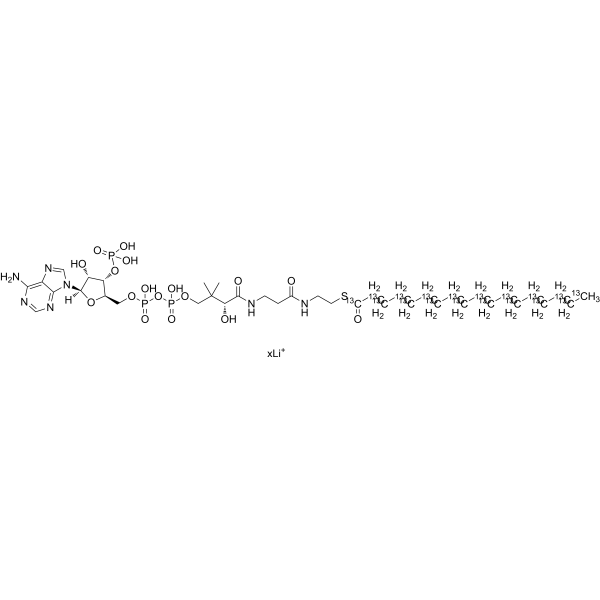
-
- HY-135867
-
|
|
Endogenous Metabolite
Enterovirus
HCV
Topoisomerase
SARS-CoV
|
Infection
|
|
NHC-triphosphate is an active phosphorylated intracellular metabolite of β-d-N4-Hydroxycytidine (NHC) (HY-125033) as a triphosphate form . NHC-triphosphate is a weak alternative substrate for the viral polymerase and can be incorporated into HCV replicon RNA .
|
-

-
- HY-15779
-
|
|
SphK
Apoptosis
|
Cancer
|
|
K145 is a selective, substrate-competitive and orally active SphK2 inhibitor with an IC50 of 4.3 µM and a Ki of 6.4 µM. K145 is inactive against SphK1 and other protein kinases. K145 induces cell apoptosis and has potently antitumor activity .
|
-
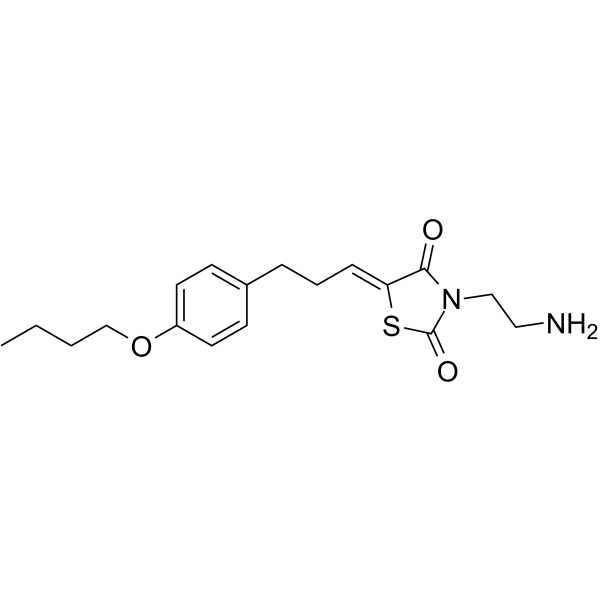
-
- HY-15779A
-
|
|
SphK
Apoptosis
|
Cancer
|
|
K145 hydrochloride is a selective, substrate-competitive and orally active SphK2 inhibitor with an IC50 of 4.3 µM and a Ki of 6.4 µM. K145 hydrochloride is inactive against SphK1 and other protein kinases. K145 hydrochloride induces cell apoptosis and has potently antitumor activity .
|
-

-
- HY-N7136
-
|
|
Cytochrome P450
|
Metabolic Disease
|
|
α-Terpinyl acetate is a monoterpene ester isolated from Laurus nobilis L. essential oil. α-Terpinyl acetate is a competitive P450 2B6 substrate which binding to the active site of P450 2B6 with a Kd value of 5.4 μM .
|
-
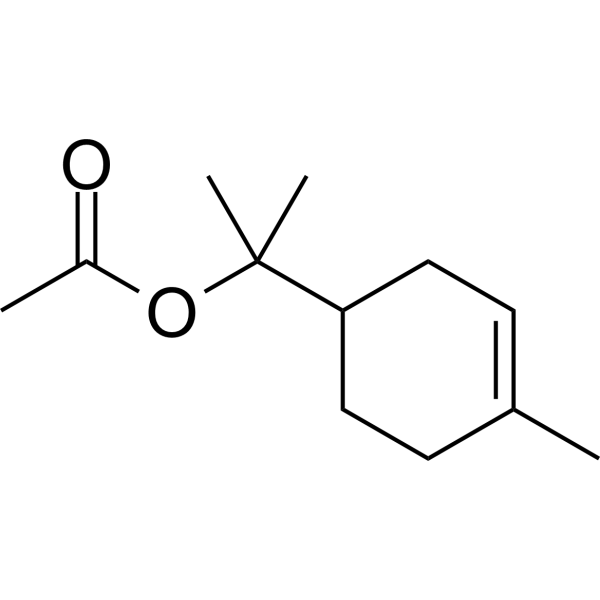
-
- HY-B0804
-
Nadolol
1 Publications Verification
SQ-11725
|
Adrenergic Receptor
|
Cardiovascular Disease
|
|
Nadolol (SQ-11725) is a non-selective and orally active β-adrenergic receptors blocker and is a substrate of organic anion transporting polypeptide 1A2 (OATP1A2). Nadolol has the the potential for high blood pressure, angina pectoris and vascular headaches research .
|
-
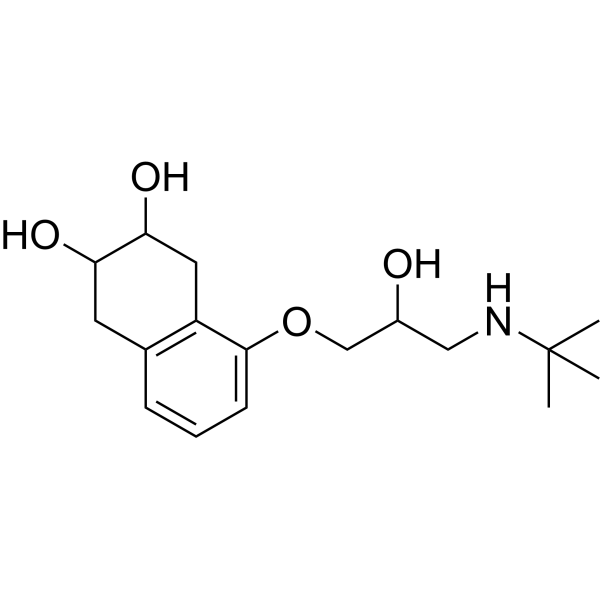
-
- HY-135867A
-
|
|
Endogenous Metabolite
Enterovirus
HCV
Topoisomerase
|
Infection
|
|
NHC-triphosphate tetrasodium is an active phosphorylated intracellular metabolite of β-d-N4-Hydroxycytidine (NHC) (HY-125033) as a triphosphate form . NHC-triphosphate tetrasodium is a weak alternative substrate for the viral polymerase and can be incorporated into HCV replicon RNA .
|
-

-
- HY-135867F
-
|
|
Endogenous Metabolite
Enterovirus
HCV
Topoisomerase
SARS-CoV
|
Infection
|
|
NHC-diphosphate triammonium is an active phosphorylated intracellular metabolite of β-d-N4-Hydroxycytidine (NHC) (HY-125033) as a diphosphate form . NHC-diphosphate triammonium is a weak alternative substrate for the viral polymerase and can be incorporated into HCV replicon RNA .
|
-
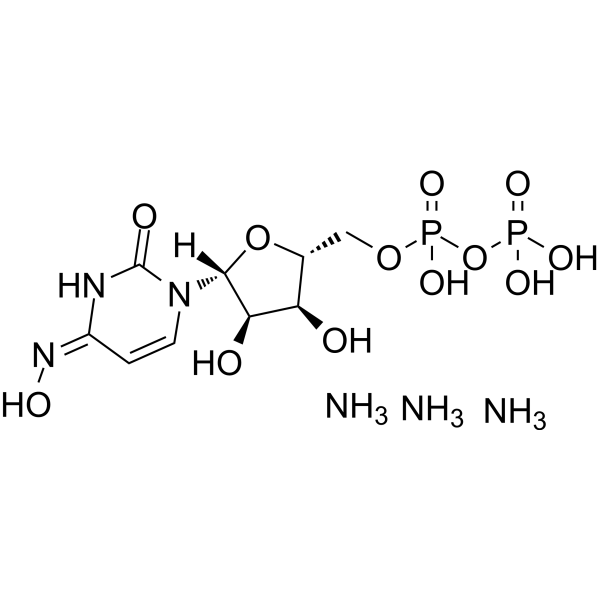
-
- HY-135867E
-
|
|
Endogenous Metabolite
Enterovirus
HCV
Topoisomerase
SARS-CoV
|
Infection
|
|
NHC-triphosphate tetraammonium is an active phosphorylated intracellular metabolite of β-d-N4-Hydroxycytidine (NHC) (HY-125033) as a triphosphate form . NHC-triphosphate tetraammonium is a weak alternative substrate for the viral polymerase and can be incorporated into HCV replicon RNA .
|
-
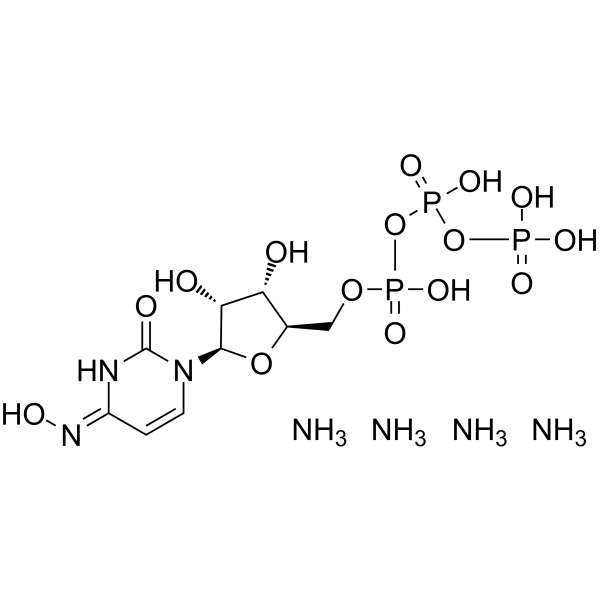
-
- HY-P0266B
-
|
Ac-SDKP acetate
|
Angiotensin-converting Enzyme (ACE)
|
Inflammation/Immunology
|
|
N-Acetyl-Ser-Asp-Lys-Pro (Ac-SDKP) acetate is a specific substrate for the N-terminal active site of angiotensin-converting enzyme (ACE). N-Acetyl-Ser-Asp-Lys-Pro acetate is a natural inhibitor of pluripotent hematopoietic stem cell proliferation. Anti-inflammatory and antifibrotic properties .
|
-
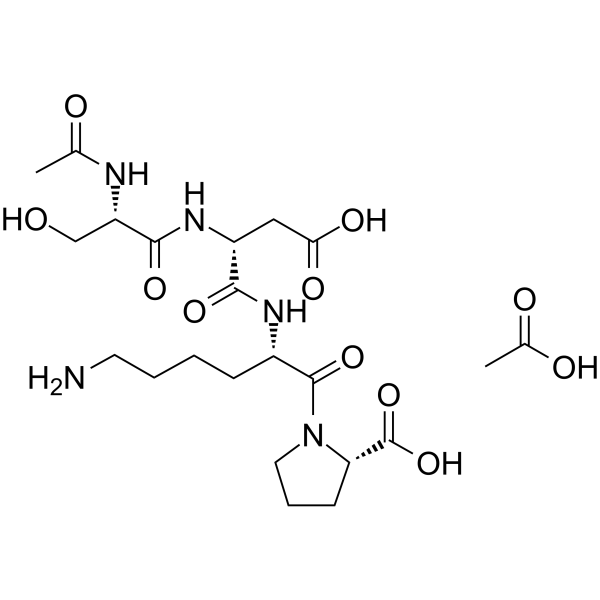
-
- HY-D1584
-
|
|
Phospholipase
|
Others
|
|
C12 NBD sphingomyelin is an active derivative of sphingomyelin (HY-113498) that is tagged with fluorescent C12 nitrobenzoxadiazole (C12 NBD). C12 NBD sphingomyelin can be used as a sphingomyelinase substrate for studying the metabolism and transport of sphingomyelins (Ex=470 nm, Em=525 nm) .
|
-
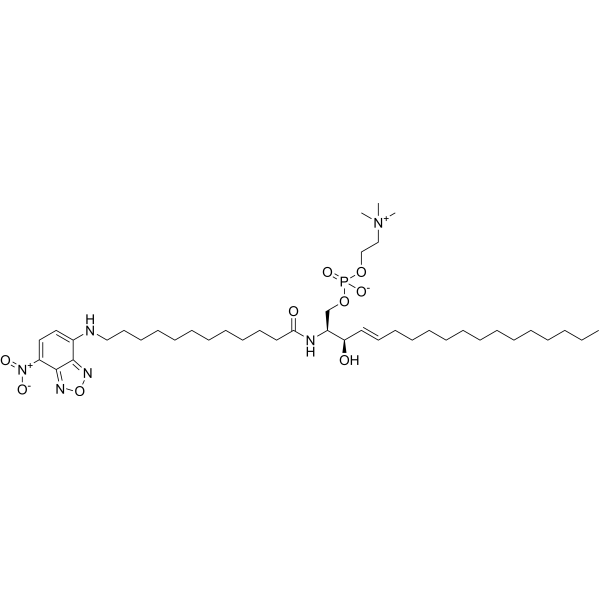
-
- HY-D1575
-
|
|
Fluorescent Dye
|
Others
|
|
C6 NBD galactosylceramide is an active derivative of galactosylceramide that is tagged with fluorescent C6 nitrobenzoxadiazole (C6 NBD). C6 NBD galactosylceramide can be used as a substrate for neutral β-glycosylceramidase (GCase) to study intracellular localization and metabolism of galactosylceramide (Ex=nm, Em=525) .
|
-

-
- HY-137854
-
|
|
Biochemical Assay Reagents
|
Others
|
|
Naphthol AS-BI N-acetyl-β-D-glucosaminide acts as a substrate and reacts directly with N-acetyl-β-glucosaminidase enzyme. Naphthol AS-BI N-acetyl-β-D-glucosaminide can detect and localize the active region of N-acetyl-β-glucosaminidase enzyme visually .
|
-

-
- HY-120111
-
|
MW01-18-150SRM
|
p38 MAPK
Autophagy
|
Neurological Disease
Inflammation/Immunology
|
|
MW150 (MW01-18-150SRM) is a selective, CNS penetrant, and orally active inhibitor of p38α MAPK with a Ki of 101 nM. MW-150 inhibits the ability of the endogenous p38α MAPK to phosphorylate an endogenous substrate MK2 in activated glia .
|
-
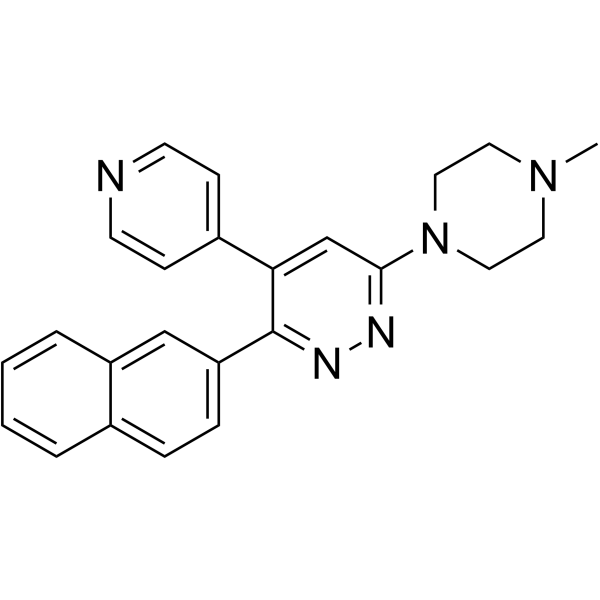
-
- HY-107597
-
Halicin
1 Publications Verification
SU3327
|
JNK
|
Metabolic Disease
Inflammation/Immunology
|
|
Halicin (SU3327) is a potent, selective and substrate-competitive JNK inhibitor with an IC50 of 0.7 μM. Halicin also inhibits protein-protein interactions between JNK and JNK Interacting Protein (JIP) with an IC50 of 239 nM. Halicin shows less active against p38α and Akt kinase .
|
-
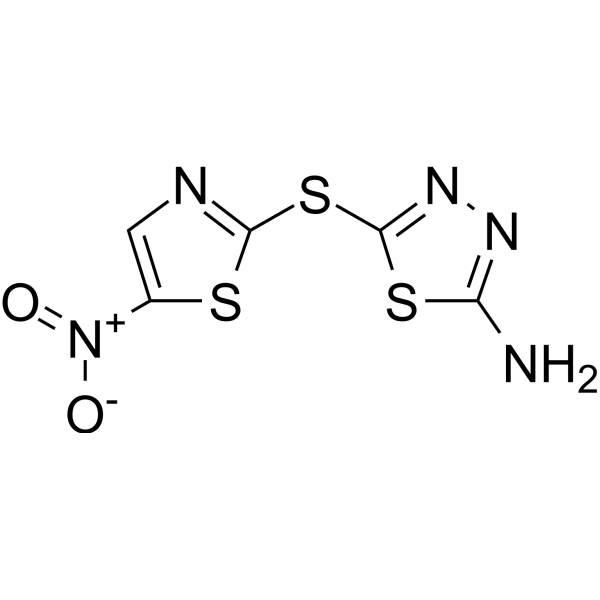
-
- HY-143903
-
|
|
PIN1
|
Cancer
|
|
ZL-Pin13 is a high potent cell-active covalent inhibitor targeting the Pin1 (Peptidyl-Prolyl Isomerase NIMA-Interacting-1) with an IC50 of 67 nM. ZL-Pin13 effectively inhibits the proliferation and downregulated the Pin1 substrates in MDA-MB-231 cells .
|
-
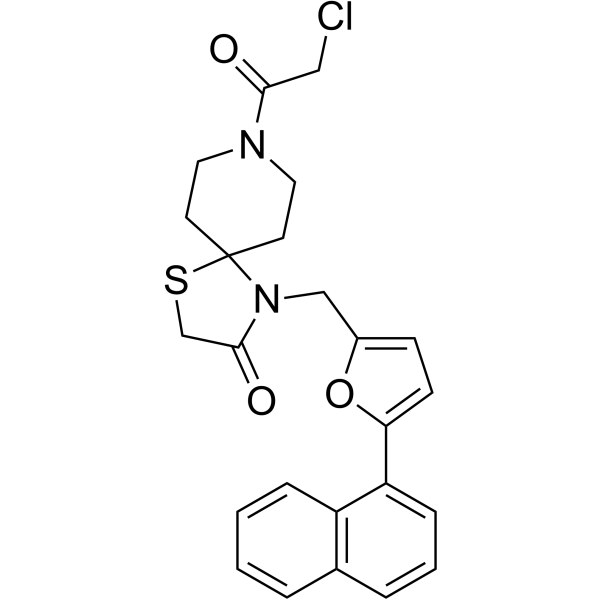
-
- HY-110196
-
|
|
Others
|
Others
|
|
(S)-PFI-2 hydrochloride is an inhibitor of lysine methyltransferase SETD7 and is approximately 500-fold more active than its enantiomer (R)-PFI-2. (R)-PFI-2 is a cofactor-dependent and substrate-competitive inhibitor. (R)-PFI-2 can occupy the substrate peptide binding groove of SETD7 (including the catalytic lysine binding channel) and interact with the cofactor The donor methyl group is in direct contact. However, (S)-PFI-2 was not observed to have the same interaction as (R)-PFI-2 .
|
-
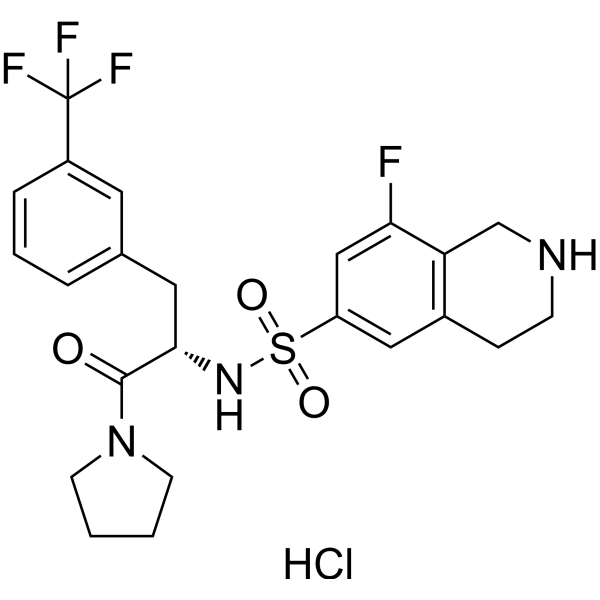
-
- HY-B0777
-
|
CL301423
|
Antibiotic
BCRP
P-glycoprotein
Parasite
|
Infection
|
|
Moxidectin (CL301423) is an orally active macrolide (ML) anthelmintic for the prevention and control of heartworms and roundworms. Moxidectin is also a substrate of BCRP and P-glycoprotein (P-gp) in vivo, and is secreted into breast milk and effluxed from the host and parasite mediated by Bcrp1 and P-gp. This may be related to the presence of chemical residues in milk .
|
-
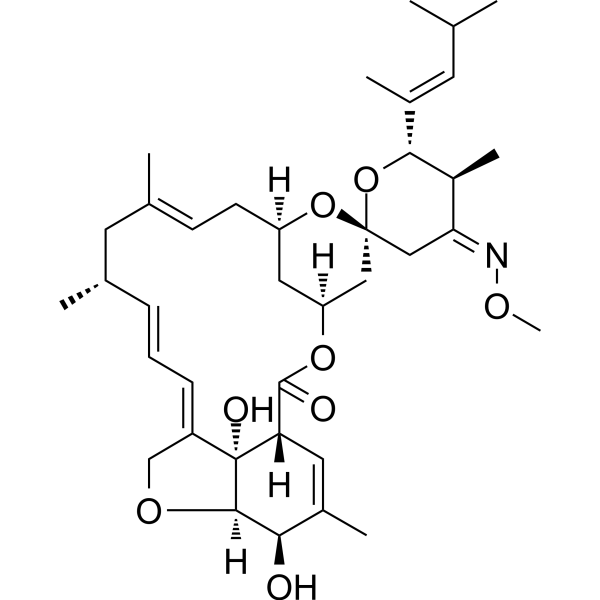
-
- HY-16397
-
|
Phenethylbiguanide
|
Mitochondrial Metabolism
AMPK
Apoptosis
|
Metabolic Disease
Cancer
|
|
Phenformin (1-phenethylbiguanide) is an orally active antidiabetic and anticancer agent. Phenformin has an incidence of associated lactic acidosis. Phenformin acts through acting AMPK activation and blocking mTOR pathway. Phenformin is also a substrate of P-glycoprotein (P-gp), and an OXPHOS inhibitor. Phenformin induces cancer cell apoptosis .
|
-
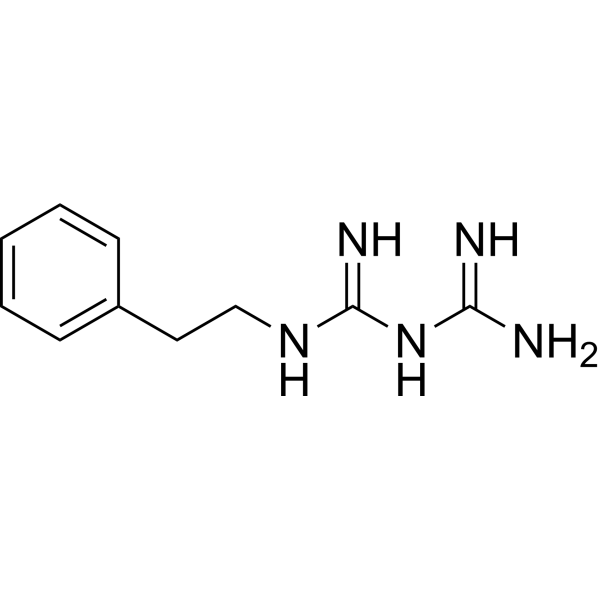
-
- HY-162001
-
|
|
CDK
|
Cancer
|
|
INX-315 is an orally active and selective CDK2 inhibitor that induces cell cycle arrest in the G1 phase. INX-315 reduces CDK2 substrate phosphorylation and inhibits tumor growth in a dose-dependent manner in xenograft mouse models. INX-315 may be used in cancer research .
|
-

-
- HY-P5371
-
|
|
Thrombin
|
Others
|
|
TFLLRNPNDK-NH2 is a biological active peptide. (This peptide is a thrombin receptor activating peptide. This PAR-1 agonist peptide reversibly binds to PAR-1 mimicking the 'tethered ligand' that thrombin makes available through proteolytic cleavage of substrate. It is also known to cause increase in liquid and protein permeability much like thrombin.)
|
-
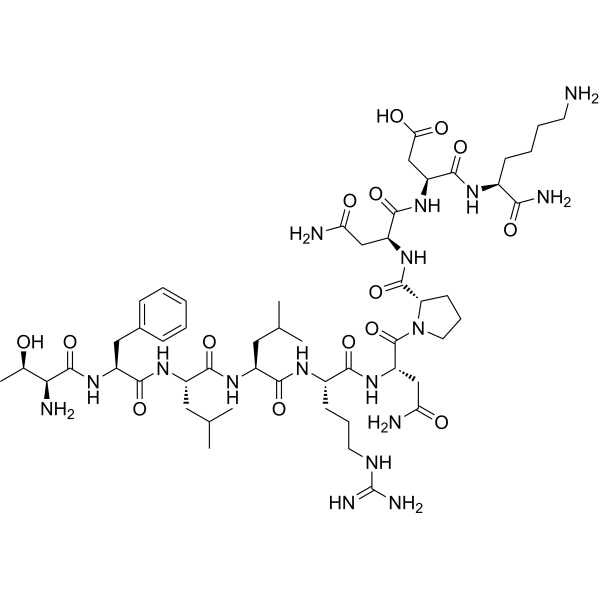
- HY-B1746
-
|
|
Endogenous Metabolite
|
Neurological Disease
|
|
Pyridoxamine 5′-phosphate is the active form of vitamin B6 bound to phosphoric acid. Pyridoxamine 5′-phosphate is the aminated form of pyridoxal 5'-phosphate hydrate (HY-W011727A) and as co-factor of a variety of enzymes central metabolite, potent antioxidant, vitamin B6 vitamer and enzyme substrate. Pyridoxamine 5′-phosphate can be interconverted with pyridoxal 5'-phosphate hydrate .
|
-
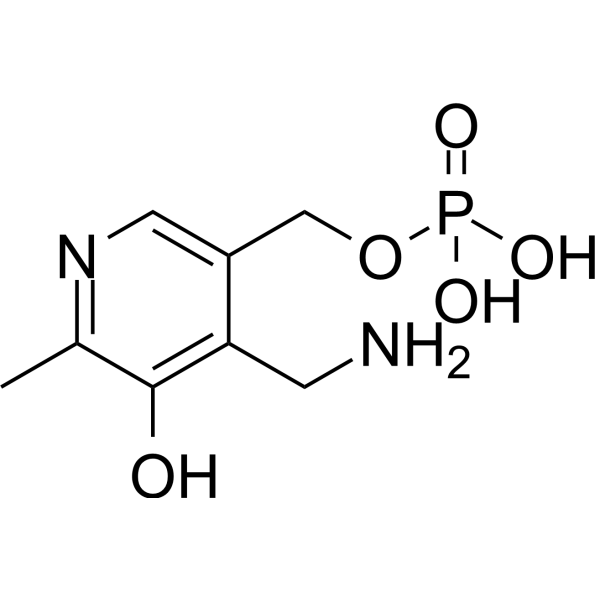
- HY-120111A
-
|
MW01-18-150SRM hydrochloride
|
p38 MAPK
Autophagy
|
Neurological Disease
Inflammation/Immunology
|
|
MW-150 hydrochloride (MW01-18-150SRM hydrochloride) is a selective, CNS penetrant, and orally active inhibitor of p38α MAPK with a Ki of 101 nM. MW-150 hydrochloride (MW01-18-150SRM hydrochloride) inhibits the ability of the endogenous p38α MAPK to phosphorylate an endogenous substrate MK2 in activated glia .
|
-
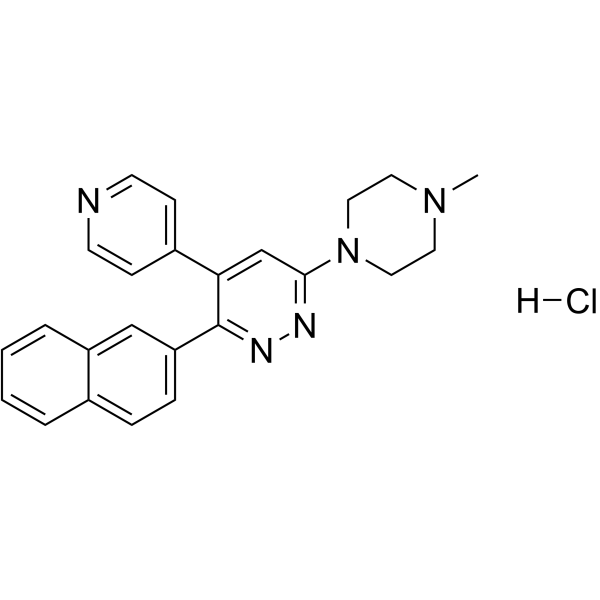
- HY-122643
-
|
|
Bacterial
|
Infection
|
|
NITD-916, a 4-hydroxy-2-pyridone derivative, is an orally active and highly lipophilic mycobacterial enoyl reductase InhA inhibitor with an IC50 of 570 nM. NITD-916 forms a ternary complex with InhA and NADH to block access to the fatty acyl substrate binding pocket. NITD-916 has potent anti-tuberculosis effects .
|
-

- HY-131131
-
|
|
Fluorescent Dye
|
Others
|
|
5-CFDA-AM is a cell-permeable esterase substrate that can be used as an active probe to measure enzyme activity and cell membrane integrity. 5-CFDA-AM is electroneutral and can enter the cell at a lower concentration than CFDA, where it is hydrolysed by intracellular esterases to produce carboxyfluorescein. Carboxyfluorescein contains an additional negative charge and can be better retained in the cell .
|
-
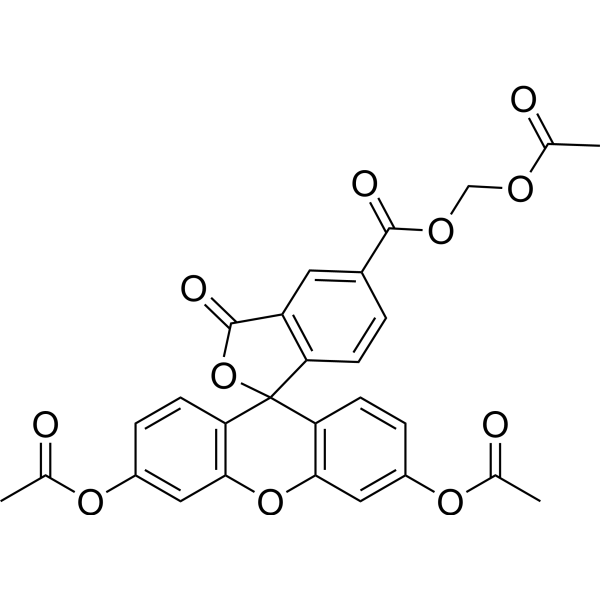
- HY-114511
-
|
|
Others
|
Cardiovascular Disease
|
|
BMS-593214 is an active site-directed factor (F) VIIa inhibitor. BMS-593214 shows antithrombotic and antihaemostatic properties. BMS-593214 is a direct competitive inhibitor of human FVIIa and a non-competitive inhibitor of Viia-activated substrate FX. BMS-593214 prevents electroinduced carotid artery thrombosis (AT) and wire induced vena cava thrombosis (VT) .
|
-
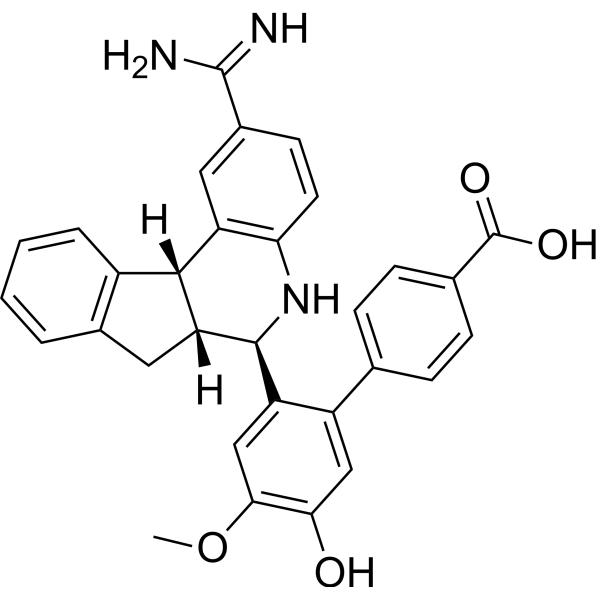
- HY-160019
-
|
|
Deubiquitinase
Mitophagy
|
Neurological Disease
|
|
MTX115325 (Example 1) is an orally active, brain-penetrating USP30 inhibitor (IC50=12 nM) with neuroprotective activity. MTX115325 increases ubiquitination (EC50=32 nM) of the mitochondrial outer membrane protein TOM20 (a USP30 substrate), increasing mitophagy. MTX115325 prevents dopaminergic neuron loss and preserves striatal dopamine .
|
-
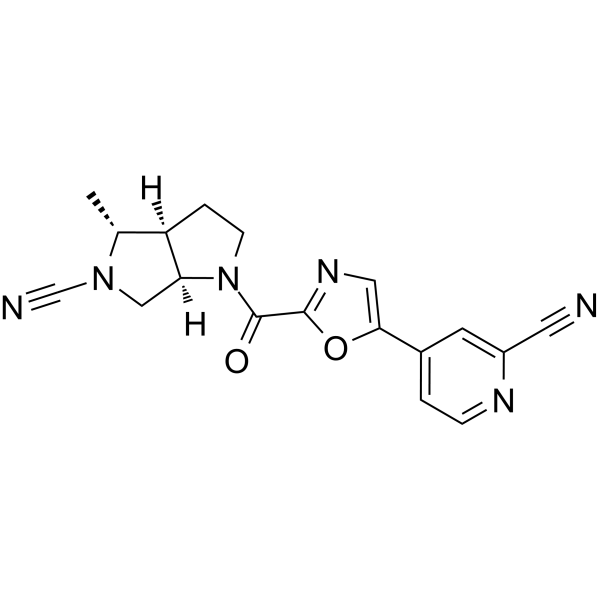
- HY-113335
-
|
Coprocholic acid
|
Endogenous Metabolite
|
Inflammation/Immunology
|
|
Trihydroxycholestanoic acid is an endogenous metabolite present in Blood that can be used for the research of Zellweger Syndrome, Refsum Disease, D Bifunctional Protein Deficiency and Infantile Refsum Disease .
|
-
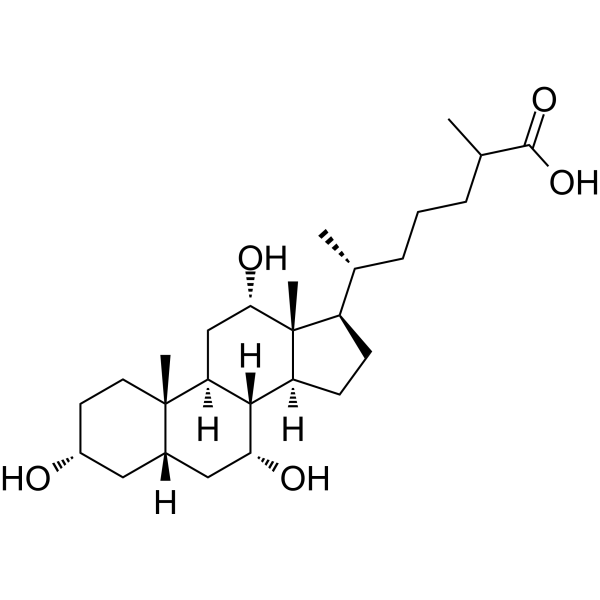
- HY-14405A
-
|
GW679769B
|
Neurokinin Receptor
Cytochrome P450
|
Neurological Disease
Cancer
|
|
Casopitant mesylate (GW679769B) is a potent, selective, brain permeable and orally active neurokinin 1 (NK1) receptor antagonist. Casopitant mesylate is a second in the class of antiemetics that acts to antagonise the emetogenic effect of substance P. Casopitant mesylate is also a substrate and a weak-to-moderate inhibitor of CYP3A4. Casopitant mesylate can be used for chemotherapy-induced nausea and vomiting (CINV) and postoperative nausea and vomiting (PONV) .
|
-
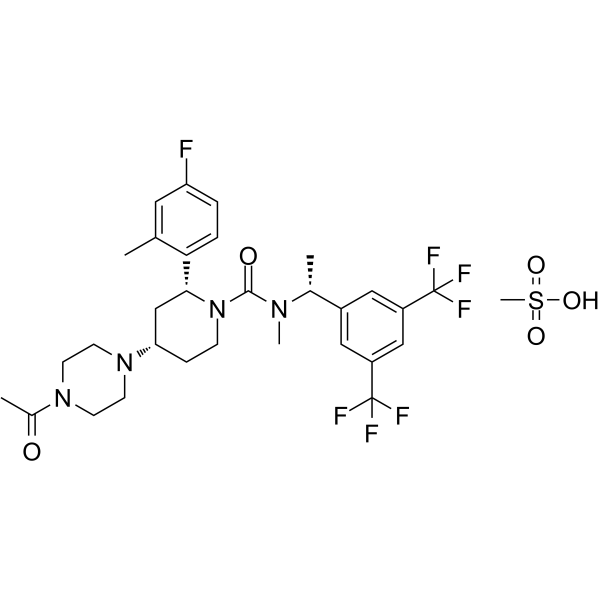
- HY-W062835
-
|
|
Src
|
Cancer
|
|
CGP77675 is an orally active and potent inhibitor of Src family kinases. CGP77675 inhibits phosphorylation of peptide substrates and autophosphorylation of purified Src (IC50s of 5-20 and 40 nM, respectively), and also inhibits Src, EGFR, KDR, v-Abl, and Lck with IC50s of 5-20, 40, 20, 150, 1000, 310, and 290 nM, respectively. Anticancer activity .
|
-

- HY-120111B
-
|
MW01-18-150SRM dihydrochloride dihydrate
|
p38 MAPK
Autophagy
|
Neurological Disease
Inflammation/Immunology
|
|
MW-150 dihydrochloride dihydrate (MW01-18-150SRM dihydrochloride dihydrate) is a selective, CNS penetrant, and orally active inhibitor of p38α MAPK with a Ki of 101 nM. MW-150 dihydrochloride dihydrate (MW01-18-150SRM dihydrochloride dihydrate) inhibits the ability of the endogenous p38α MAPK to phosphorylate an endogenous substrate MK2 in activated glia .
|
-
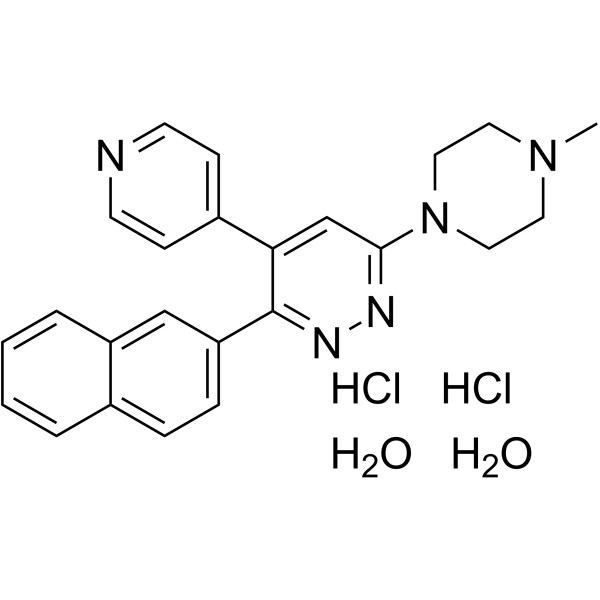
- HY-13463B
-
|
AKR-501 hydrochloride; E5501 hydrochloride; YM477 hydrochloride
|
Thrombopoietin Receptor
|
Cardiovascular Disease
|
|
Avatrombopag (AKR-501) hydrochloride is an orally active, nonpeptide thrombopoietin (TPO) receptor agonist (EC50=3.3 nM). Avatrombopag hydrochloride mimics the biological activities of TPO. Avatrombopag hydrochloride increases platelet production by activating the intracellular signaling system, and promotes production of platelets and megakaryocytes from hemopoietic precursor cells. Avatrombopag hydrochloride is a substrate of cytochrome P450 (CYP) 2C9 and CYP3A .
|
-
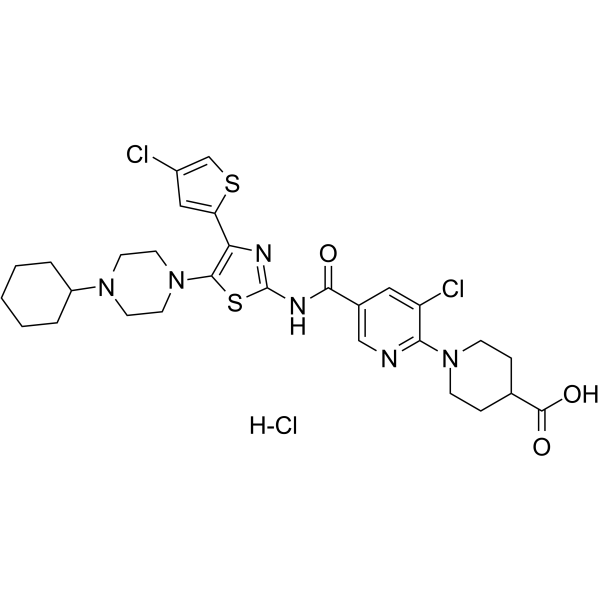
- HY-13463
-
|
AKR-501; E5501; YM477
|
Thrombopoietin Receptor
|
Inflammation/Immunology
|
|
Avatrombopag (AKR-501) is an orally active, nonpeptide thrombopoietin (TPO) receptor agonist (EC50=3.3 nM). Avatrombopag mimics the biological activities of TPO. Avatrombopag increases platelet production by activating the intracellular signaling system, and promotes production of platelets and megakaryocytes from hemopoietic precursor cells. Avatrombopag is a substrate of cytochrome P450 (CYP) 2C9 and CYP3A .
|
-

- HY-W062835A
-
|
|
Src
|
Cancer
|
|
CGP77675 hydrate is an orally active and potent inhibitor of Src family kinases. CGP77675 hydrate inhibits phosphorylation of peptide substrates and autophosphorylation of purified Src (IC50s of 5-20 and 40 nM, respectively),and also inhibits Src, EGFR, KDR, v-Abl, and Lck with IC50s of 0.02, 0.15, 1.0, 0.31, and 0.29 μM, respectively. Anticancer activity .
|
-
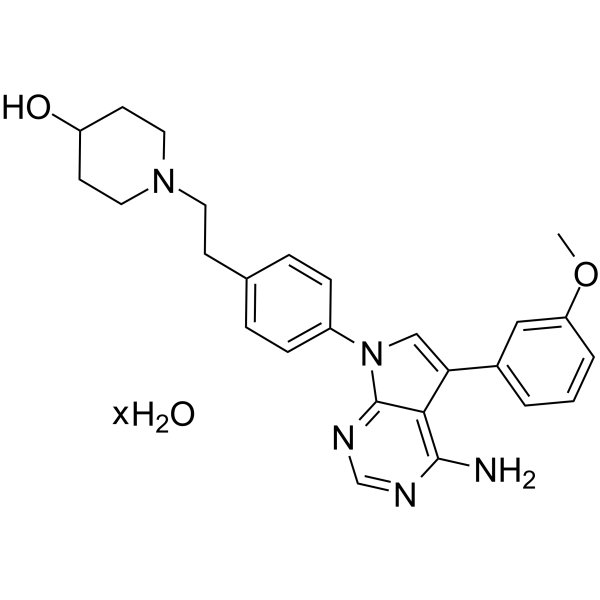
- HY-13463A
-
|
AKR-501 maleate; E5501 maleate; YM477 maleate
|
Thrombopoietin Receptor
|
Inflammation/Immunology
|
|
Avatrombopag maleate (AKR-501) is an orally active, nonpeptide thrombopoietin (TPO) receptor agonist (EC50=3.3 nM). Avatrombopag maleate mimics the biological activities of TPO. Avatrombopag maleate increases platelet production by activating the intracellular signaling system, and promotes production of platelets and megakaryocytes from hemopoietic precursor cells. Avatrombopag maleate is a substrate of cytochrome P450 (CYP) 2C9 and CYP3A .
|
-
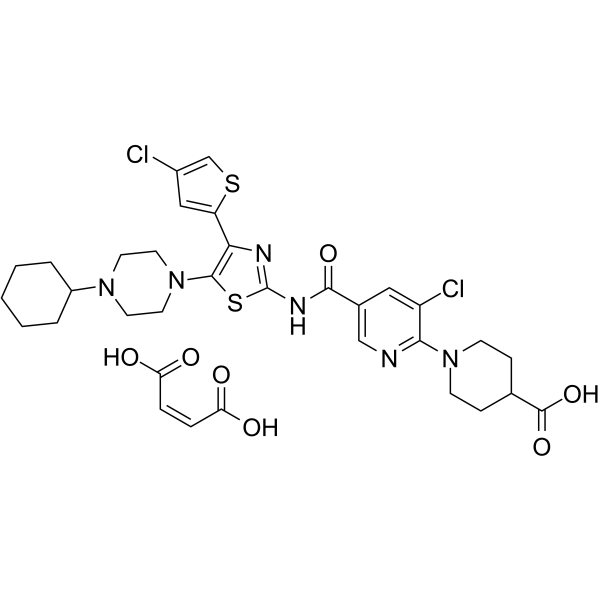
- HY-B0777R
-
|
CL301423 (Standard)
|
Antibiotic
BCRP
P-glycoprotein
Parasite
|
Infection
|
|
Moxidectin (Standard) is the analytical standard of Moxidectin. This product is intended for research and analytical applications. Moxidectin (CL301423) is an orally active macrolide (ML) anthelmintic for the prevention and control of heartworms and roundworms. Moxidectin is also a substrate of BCRP and P-glycoprotein (P-gp) in vivo, and is secreted into breast milk and effluxed from the host and parasite mediated by Bcrp1 and P-gp. This may be related to the presence of chemical residues in milk .
|
-

- HY-P4931
-
|
Mca-Lys-Pro-Leu-Gly-Leu-Dpa-Ala-Arg-NH2
|
MMP
|
Cancer
|
|
Mca-Lys-Pro-Leu-Gly-Leu-Dap(Dnp)-Ala-Arg-NH2 (FS-6) is a fluorescent peptide that is a quenched MMP peptide substrate. Mca-Lys-Pro-Leu-Gly-Leu-Dap(Dnp)-Ala-Arg-NH2 can be used for real-time quantification of MMP enzymatic activity. Mca-Lys-Pro-Leu-Gly-Leu-Dap(Dnp)-Ala-Arg-NH2 is an elongated peptide of MMP substrate (FS-1) and is active against collagenases (MMP-1, MMP-8, MMP-13 ) and MT1-MMP with higher specificity constants than FS-1 . (Ex/Em=325 nm/400 nm)
|
-
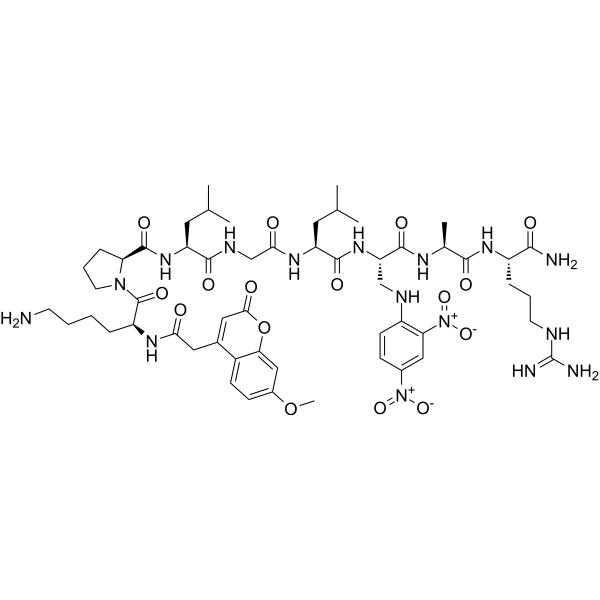
- HY-P5525
-
|
Autocamtide-3 Derived Inhibitory Peptide
|
CaMK
|
Others
|
|
AC3-I, myristoylated is a biological active peptide. (This is a myristoylated form of Autocamtide-3-Derived Inhibitory Peptide (AC3-I), a highly specific inhibitor of Calmodulin-Dependent Protein Kinase ll (CaMKII) that is resistant to proteolysis. AC3-I is derived from Autocamtide-3, a substrate for CaMKII, with the Thr-9 phosphorylation site substituted with Ala.)
|
-
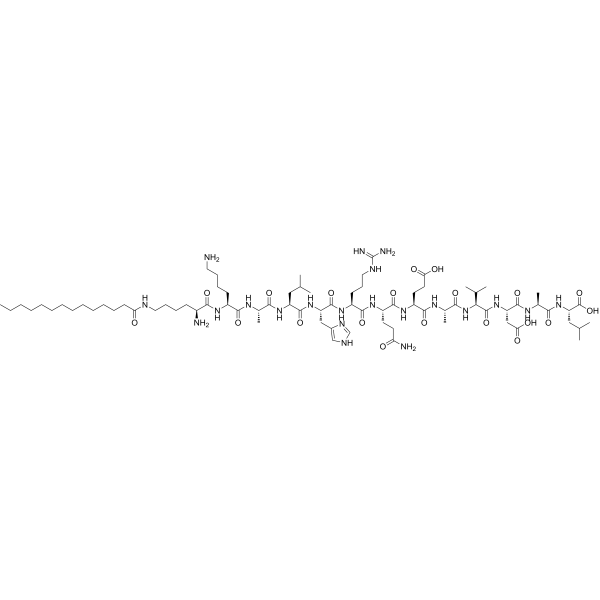
- HY-13463BS
-
|
AKR-501-d8 hydrochloride; E5501-d8 hydrochloride; YM477-d8 hydrochloride
|
Isotope-Labeled Compounds
Thrombopoietin Receptor
|
Cardiovascular Disease
|
|
Avatrombopag-d8 (hydrochloride) is deuterium labeled Avatrombopag (hydrochloride). Avatrombopag (AKR-501) hydrochloride is an orally active, nonpeptide thrombopoietin (TPO) receptor agonist (EC50=3.3 nM). Avatrombopag hydrochloride mimics the biological activities of TPO. Avatrombopag hydrochloride increases platelet production by activating the intracellular signaling system, and promotes production of platelets and megakaryocytes from hemopoietic precursor cells. Avatrombopag hydrochloride is a substrate of cytochrome P450 (CYP) 2C9 and CYP3A[1][2][3].
|
-

- HY-W099538
-
|
Dilauryl 3,3'-Thiodipropionate
|
Biochemical Assay Reagents
|
Others
|
|
Dilauryl thiodipropionate (DLTDP), which is a sulfur-containing antioxidant commonly used to stabilize polymers and plastics against degradation caused by heat, oxygen, and UV light, acts to scavenge free radicals and others that may cause polymer chain scission and cross-linked active substances, in addition, DLTDP has been used as an additive to lubricants, oils and other industrial fluids to improve their oxidation stability, the long hydrocarbon chain in DLTDP makes it low volatility and compatible with many materials and Good compatibility with substrates.
|
-
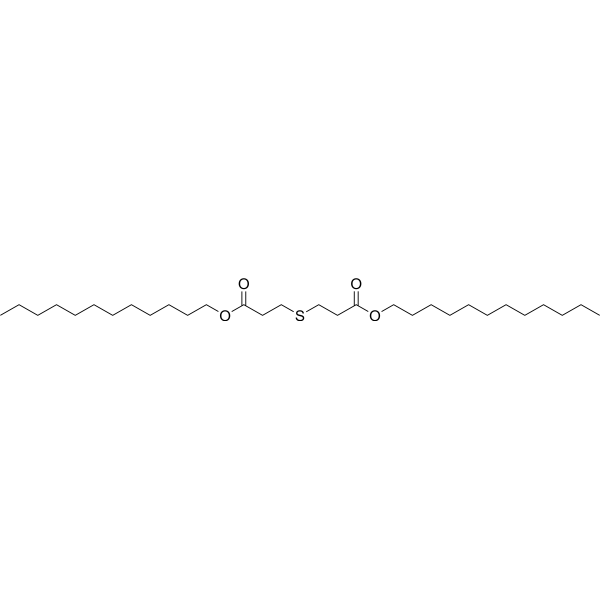
- HY-126077
-
|
LXI-15029
|
mTOR
|
Inflammation/Immunology
Cancer
|
|
MTI-31 (LXI-15029) is a potent, orally active and highly selective inhibitor of mTORC1 and mTORC2. MTI-31 is selective for mTOR (Kd: 0.20 nM) versus PIK3CA, PIK3CB and PIK3G with >5,000 fold selectivity in mTOR binding assays. MTI-31 shows an IC50 of 39 nM for mTOR in LANCE assay of mTOR substrate phosphorylation with 100 μM ATP. MTI-31 can be used for the research of breast cancer .
|
-
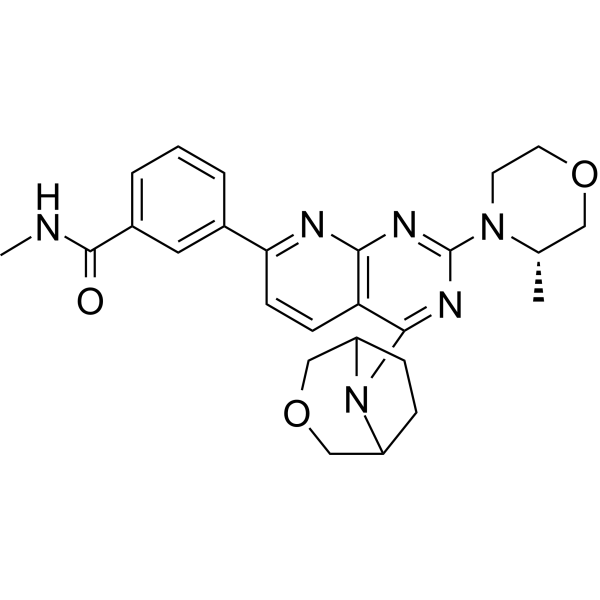
- HY-155995
-
|
MK-905
|
Others
|
Cancer
|
|
Pro-905 is a phosphite peptide with antitumor activity. Pro-905 delivers the active nucleotide antimetabolite thioguanosine monophosphate (TGMP) to the tumor. Pro-905 effectively prevents incorporation of purine salvage substrates into nucleic acids and inhibits colony formation in human malignant peripheral nerve sheath tumors (MPNST) cells. Pro-905 inhibits purine salvage incorporation to nucleic acids and prevents cell growth. Pro-905 inhibits the growth of MPNST and enhances the anti-tumor efficacy of JHU395 (HY-124778) .
|
-
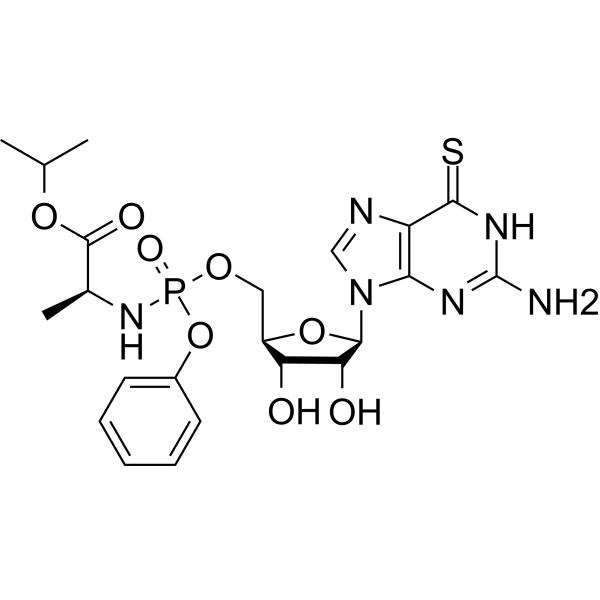
- HY-P5380
-
|
|
MMP
|
Others
|
|
TNO211 is a biological active peptide. (Matrix Metalloproteinases (MMPs) are a large family of endopeptidases. Collectively, MMPs can degrade all kinds of extracellular matrix proteins, and can also process a number of bioactive molecules. They are known to be involved in the cleavage of cell surface receptors, the release of apoptotic ligands, and chemokine/cytokine inactivation. MMPs are also thought to play a major role in cell behaviors such as cell proliferation, migration (adhesion/dispersion), differentiation, angiogenesis, apoptosis, and host defense.This peptide is a highly soluble fluorogenic MMP substrate for MMP-2, 8, 12, 13 and 14, containing the MMP cleavable Gly-Leu bond and EDANS/DABCYL. Fluorogenic assays using TNO211 are sensitive and can detect MMP activity in culture medium from endothelial cells and untreated synovial fluid from patients. Abs/Em = 340/490 nm.)
|
-

- HY-153321
-
|
BTK-IN-24
|
Btk
PROTACs
|
Inflammation/Immunology
Cancer
|
|
NX-5948 (BTK-IN-24) is an orally active chimeric targeting molecule (CTM) that induces specific BTK protein degradation by the cereblon E3 ligase (CRBN) complex without degradation of other cereblon neo-substrates. NX-5948 mediates potent anti-inflammatory activity via BTK degradation with resultant inhibition of B cell activation. NX-5948 exhibits potent tumor growth inhibition in TMD8 xenograft models that contain either wild-type BTK or BTKi-resistant mutations. NX-5948 is efficacious in a mouse collageninduced arthritis (CIA) model. NX-5948 can cross the blood brain barrier (BBB). NX-5948 is a PROTAC composed of the ligand for target protein, a linker, and a cereblon E3 ligase (CRBN) complex (Red: ligand for target protein; Blue: CRBN; Black: linker) .
|
-

| Cat. No. |
Product Name |
Type |
-
- HY-D1584
-
|
|
Fluorescent Dyes/Probes
|
|
C12 NBD sphingomyelin is an active derivative of sphingomyelin (HY-113498) that is tagged with fluorescent C12 nitrobenzoxadiazole (C12 NBD). C12 NBD sphingomyelin can be used as a sphingomyelinase substrate for studying the metabolism and transport of sphingomyelins (Ex=470 nm, Em=525 nm) .
|
-
- HY-131131
-
|
|
Fluorescent Dyes/Probes
|
|
5-CFDA-AM is a cell-permeable esterase substrate that can be used as an active probe to measure enzyme activity and cell membrane integrity. 5-CFDA-AM is electroneutral and can enter the cell at a lower concentration than CFDA, where it is hydrolysed by intracellular esterases to produce carboxyfluorescein. Carboxyfluorescein contains an additional negative charge and can be better retained in the cell .
|
-
- HY-D1686
-
|
|
Fluorescent Dyes/Probes
|
|
Biotin-16-UTP is an active substrate for RNA polymerase. Biotin-16-UTP can replace UTP in the in vitro transcription reaction for RNA labeling .
|
-
- HY-D1575
-
|
|
Dyes
|
|
C6 NBD galactosylceramide is an active derivative of galactosylceramide that is tagged with fluorescent C6 nitrobenzoxadiazole (C6 NBD). C6 NBD galactosylceramide can be used as a substrate for neutral β-glycosylceramidase (GCase) to study intracellular localization and metabolism of galactosylceramide (Ex=nm, Em=525) .
|
| Cat. No. |
Product Name |
Type |
-
- HY-W099538
-
|
Dilauryl 3,3'-Thiodipropionate
|
Biochemical Assay Reagents
|
|
Dilauryl thiodipropionate (DLTDP), which is a sulfur-containing antioxidant commonly used to stabilize polymers and plastics against degradation caused by heat, oxygen, and UV light, acts to scavenge free radicals and others that may cause polymer chain scission and cross-linked active substances, in addition, DLTDP has been used as an additive to lubricants, oils and other industrial fluids to improve their oxidation stability, the long hydrocarbon chain in DLTDP makes it low volatility and compatible with many materials and Good compatibility with substrates.
|
-
- HY-134423
-
|
Stearoyl-CoA lithium
|
Biochemical Assay Reagents
|
|
Stearoyl coenzyme A (Stearoyl-CoA) lithium is an active compound that can be used as a substrate for the determination of stearoyl-Coenzyme desaturase in microsomes .
|
-
- HY-134421
-
|
|
Biochemical Assay Reagents
|
|
2-Butenoyl coenzyme A (lithium), an active compound, can be used as a substrate for plasmodium falciparum enyl-ACP reductases and other enyl-CoA reductases. 2-Butenoyl coenzyme A lithium can be used as a substrate analogue to study the kinetics of β-hydroxyacyl-acyl-carrier protein (ACP) dehydratase (FabZ) .
|
-
- HY-137854
-
|
|
Enzyme Substrates
|
|
Naphthol AS-BI N-acetyl-β-D-glucosaminide acts as a substrate and reacts directly with N-acetyl-β-glucosaminidase enzyme. Naphthol AS-BI N-acetyl-β-D-glucosaminide can detect and localize the active region of N-acetyl-β-glucosaminidase enzyme visually .
|
| Cat. No. |
Product Name |
Target |
Research Area |
-
- HY-P2668
-
|
|
Peptides
|
Others
|
|
Cdk5 Substrate is a biological active peptide. (substrate for the cdc2 protein kinase)
|
-
- HY-P5441
-
|
|
Peptides
|
Others
|
|
KRpTIRR is a biological active peptide. (Phosphatase substrate.)
|
-
- HY-P5447
-
|
|
Peptides
|
Others
|
|
RRLIEDAEpYAARG is a biological active peptide. (Phosphatase substrate.)
|
-
- HY-P5449
-
|
|
Peptides
|
Others
|
|
p70 S6 Kinase substrate is a biological active peptide. (This peptide is a substrate for p70 ribosomal S6 kinase.)
|
-
- HY-P3123
-
|
|
Peptides
|
Others
|
|
Dnp-RPLALWRS is a biological active peptide. (matrilysin substrate)
|
-
- HY-P5485
-
|
|
Peptides
|
Others
|
|
Dabcyl-QALPETGEE-Edans is a biological active peptide. (Sortase Substrate)
|
-
- HY-P5428
-
|
|
Peptides
|
Others
|
|
Cdc2 kinase substrate is a biological active peptide. (The native peptide HATPPKKKRK is a substrate for cyclin-dependent protein kinase 1 (CDC2; CDK1).)
|
-
- HY-P0320
-
|
|
Phosphatase
|
Others
|
|
EGF Receptor Substrate 2 (Phospho-Tyr5) acetate, a biologically active peptide, is a tyrosine phosphate substrate. EGF Receptor Substrate 2 (Phospho-Tyr5) acetate can be used to detect protein tyrosine phosphatases activity .
|
-
- HY-P0320A
-
|
|
Phosphatase
Biochemical Assay Reagents
|
Others
|
|
EGF Receptor Substrate 2 (Phospho-Tyr5) acetate, a biologically active peptide, is a tyrosine phosphate substrate. EGF Receptor Substrate 2 (Phospho-Tyr5) acetate can be used to detect protein tyrosine phosphatases activity .
|
-
- HY-P0320B
-
|
|
Phosphatase
Biochemical Assay Reagents
|
Others
|
|
EGF Receptor Substrate 2 (Phospho-Tyr5) acetate, a biologically active peptide, is a tyrosine phosphate substrate. EGF Receptor Substrate 2 (Phospho-Tyr5) acetate can be used to detect protein tyrosine phosphatases activity .
|
-
- HY-P5445
-
|
|
Peptides
|
Others
|
|
Neurogranin 28-43 is a biological active peptide. (selective PKC substrate)
|
-
- HY-P5385
-
|
|
Peptides
|
Others
|
|
Renin substrate, angiotensinogen (1-14), rat is a biological active peptide. (This peptide is derived from rat angiotensinogen amino acid residues 1-14. It is a synthetic renin substrate.)
|
-
- HY-P5376
-
|
|
Peptides
|
Others
|
|
MeOSuc-Arg-Pro-Tyr-pNA is a biological active peptide. (chymotrypsin substrate)
|
-
- HY-P5375
-
|
|
Peptides
|
Others
|
|
O-Linked GlcNAc transferase substrate is a biological active peptide. (A peptide substrate of O-linked GlcNAc transferase (OGT), a eukaryotic glycosyltransferase that uses UDP-GlcNAc as a glycosyl donor.)
|
-
- HY-P5507
-
|
Erktide
|
Peptides
|
Others
|
|
ERK2 Substrate (Erktide) is a biological active peptide. (Erktide is a peptide substrate for ERK2 (extracellular regulated protein kinase 2) whose activity is regulated by mitogenic stimuli.)
|
-
- HY-P5432
-
|
IRAK-1 (360-380)
|
Peptides
|
Others
|
|
IRAK-4 Peptide substrate (IRAK-1 (360-380)) is a biological active peptide. (This is a substrate peptide for Interleukin-1 Receptor-Associated Kinase (IRAK) 4)
|
-
- HY-P5386
-
|
|
Peptides
|
Others
|
|
H-d-Val-Leu-Arg-AFC is a biological active peptide. (kallikrein substrate)
|
-
- HY-P5456
-
|
|
Peptides
|
Others
|
|
KRPpSQRHGSKY-NH2 is a biological active peptide. (This is a phosphorylated PKC substrate peptide)
|
-
- HY-P5433F
-
|
|
Peptides
|
Others
|
|
IRS-1 Peptide, FAM labeled is a biological active peptide. (Insulin receptor substrate)
|
-
- HY-P5450
-
|
|
PDK-1
|
Others
|
|
PDKtide is a biological active peptide. (This peptide is a substrate for PDK1 (Phosphatidylinositide-Dependent Kinase 1).)
|
-
- HY-P5473
-
|
|
Peptides
|
Others
|
|
EA2 is a biological active peptide. (This is a peptide substrate for polypeptide N-acetylgalactosaminyltransferase (polypeptide GalNAc-T).)
|
-
- HY-P5434
-
|
JAK3 Peptide substrate
|
Peptides
|
Others
|
|
Jak3tide (JAK3 Peptide substrate) is a biological active peptide. (This peptide is a substrate for Jak3. It may be used used in kinase assays. Jak3tide contains the phosphorylation site at Tyr7.)
|
-
- HY-P10042
-
|
|
Peptides
|
Others
|
|
S6K Substrate is a substrate for active protein kinases, including CLK2, MRCKalpha, MRCKbeta, p70S6K, ROCK1, ROCK2, RSK1, RSK3, PIM1 .
|
-
- HY-137834A
-
|
|
Peptides
|
Others
|
|
Gly-Pro-AMC is a biological active peptide. (This is a fluorescent dipeptidylaminopeptidase IV substrate, Abs/Em=353/442 nm.)
|
-
- HY-P5467
-
|
|
Peptides
|
Others
|
|
S6(229-239), Amide, biotinalyted is a biological active peptide. (substrate for Rho-Kinase II)
|
-
- HY-P5426
-
|
|
Peptides
|
Others
|
|
Abl protein tyrosine kinase substrate is a biological active peptide. (Abltide is a peptide substrate for Abl Kinase (Abl protein tyrosine kinase), a partner in the gag-Abl fusion protein of the Abelson murine leukemia virus. Used in Western blot and kinase assay.)
|
-
- HY-P5374
-
|
|
Peptides
|
Others
|
|
MeOSuc-AAPV-AFC is a biological active peptide. (A highly specific neutrophil elastase substrate, Abs/Em=380/500 nm.)
|
-
- HY-P5431
-
|
|
Peptides
|
Others
|
|
Insulin receptor (1142-1153), pTyr1150 is a biological active peptide. (Peptide used as insulin receptor tyrosine kinase substrate.)
|
-
- HY-P4891
-
|
|
Peptides
|
Others
|
|
Angiotensin (1-12) (human) is an endogenous substrate for the production of biologically active angiotensin peptides by a non-renin-dependent mechanism .
|
-
- HY-P1906
-
|
|
CDK
|
Neurological Disease
|
|
[pThr3]-CDK5 Substrate is an effective Phospho-Thr3CDK5 Substrate. [pThr3]-CDK5 Substrate is derived from the sequence of the histone H1 peptide that docks in the active site of CDK5. [pThr3]-CDK5 Substrate is phosphorylated by CDK5 with a Km value of 6 µM .
|
-
- HY-P1906A
-
|
|
CDK
|
Neurological Disease
|
|
[pThr3]-CDK5 Substrate TFA is an effective Phospho-Thr3CDK5 Substrate. [pThr3]-CDK5 Substrate is derived from the sequence of the histone H1 peptide that docks in the active site of CDK5. [pThr3]-CDK5 Substrate is phosphorylated by CDK5 with a Km value of 6 µM .
|
-
- HY-P5383
-
|
|
MMP
|
Others
|
|
Mca-Pro-Leu-Gly-Leu-Dap(Dnp)-Ala-Arg-NH2 is a biological active peptide. (MMP substrate)
|
-
- HY-P5512
-
|
|
Peptides
|
Others
|
|
MUC5AC-3 is a biological active peptide. (glycopeptide transferase, ppGaNTase-T9 substrate)
|
-
- HY-P5355
-
|
|
Peptides
|
Others
|
|
Z-Gly-Gly-Arg-AFC is a biological active peptide. (Plasminogen Activator Acrosine Substrate, fluorescent Z-Gly-Gly-Arg-AFC)
|
-
- HY-P5511
-
|
|
Peptides
|
Others
|
|
MUC5AC-3/13 is a biological active peptide. (glycopeptide transferase, ppGaNTase-T9 substrate)
|
-
- HY-P0248F
-
|
|
Peptides
|
Others
|
|
Kemptide, 5-FAM labeled is a biological active peptide. (Kemptide is a phosphate acceptor peptide that serves as a synthetic substrate for PKA (Km = 16 μM). The corresponding fluorescent and biotinylated peptides are also proven to be good substrates for PKA. 5-FAM labeled HY-P0248)
|
-
- HY-P5433
-
|
|
Peptides
|
Others
|
|
IRS1-derived peptide is a biological active peptide. (This is a peptide fragment (979-989) of the insulin receptor substrate-1 containing the sequence motif YMXM known to bind to the two domains of SH2 on the 85kDa subunit of phosphoinositide 3-kinase.)
|
-
- HY-P5526
-
|
|
Peptides
|
Others
|
|
CCK1-specific peptide substrate is a biological active peptide. (This peptide sequence is based on rabbit muscle glycogen synthase with Ser7 phosphorylated. It is a peptide substrate for Casein Kinase I (CK1). CK1 phosphorylates Ser10. Ser7 is phosphorylated by PKA in vivo.)
|
-
- HY-P2716
-
|
|
MMP
|
Others
|
|
Mca-Arg-Pro-Lys-Pro-Tyr-Ala-Nva-Trp-Met-Lys(Dnp)-NH2 is a biological active peptide. (MMP substrate)
|
-
- HY-P5454
-
|
|
Peptides
|
Others
|
|
RS Domain derived peptide is a biological active peptide. (This peptide is a substrate for Clk/Sty and is phosphorylated by Clk/Sty protein kinase (Km=102 microM).)
|
-
- HY-P5348
-
|
|
Peptides
|
Others
|
|
Ac-LEHD-pNA is a biological active peptide. (Caspase-9 substrate; pNA (4-nitroaniline)-derived caspase substrates are widely used for the colorimetric detection of various caspase activities. Cleavage of pNA peptides by caspases generates pNA that is monitored colorimetrically at ~405 nm. pNA has maximum absorption around 408 nm.)
|
-
- HY-P5326
-
|
|
Peptides
|
Others
|
|
EDANS-CO-CH2-CH2-CO-ALERMFLSFP-Dap(DABCYL)OH is a biological active peptide. (Plasmepsin I substrate)
|
-
- HY-P5430
-
|
|
Peptides
|
Others
|
|
DYRKtide is a biological active peptide. (Dyrktide is designed as the optimal substrate sequence efficiently phosphorylated by DYRK1A, which is a dual-specificity protein kinase that is thought to be involved in brain development.)
|
-
- HY-P5529
-
|
|
Peptides
|
Others
|
|
2Abz-GLQRALEI-Lys(Dnp)-NH2 is a biological active peptide. (C4 P4-P4′ substrate)
|
-
- HY-P5378
-
|
Cathepsin S substrate
|
Peptides
|
Others
|
|
Ac-KQKLR-AMC (Cathepsin S substrate) is a biological active peptide. (Cathepsins are a class of globular lysosomal proteases, playing a vital role in mammalian cellular turnover. They degrade polypeptides and are distinguished by their substrate specificities. Cathepsin S is a cysteine proteinase involved in the pathogenesis of autoimmune diseases, atherosclerosis, cancer, obesity and related diseases.This peptide is a cathepsin S substrate fluorescently labeled with AMC (Ex/Em=354 nm/442 nm). It can be used to measure cathepsin S activity.)
|
-
- HY-P5440
-
|
|
ERK
|
Others
|
|
ERKtide is a biological active peptide. (ERKtide is a peptide substrate for ERK2. Extracellular regulated protein kinase 2 (ERK2) is a eukaryotic protein kinase whose activity is regulated by mitogenic stimuli.)
|
-
- HY-P5466
-
|
|
Peptides
|
Others
|
|
S6(229-239) is a biological active peptide. (This is a synthetic peptide substrate for S6 kinase shown to be phosphorylated by protein kinase c with phosphorylation site identified at Ser235)
|
-
- HY-W436471
-
|
|
Peptides
|
Others
|
|
H-Ala-Pro-AFC is a biological active peptide. (This is a fluorescent peptide, Abs/Em=380/500nm. It is a substrate for dipeptidyl peptidase IV (DPP IV) and Xaa-Pro dipeptidase.)
|
-
- HY-P5510
-
|
HCV NS3 protease substrate
|
Peptides
|
Others
|
|
Ac-Asp-Glu-Asp(EDANS)-Glu-Glu-Abu-ψ-(COO)Ala-Ser-Lys(DABCYL)-NH2 (HCV NS3 protease substrate) is a biological active peptide. (This peptide is a HCV protease substrate incorporating an ester bond between residues P1 and P1. Due to ready transesterification of the scissile bond to the acyl-enzyme intermediate, this substrate shows very high kcat/Km values, enabling detection of activity with subnanomolar nonstructural protein 3 (NS3 protease) concentrations. It is widely used for the continuous assay of NS3 protease activity. Substrate cleavage is proportional to the enzyme concentration with a detection limit for NS3 between 1 nM and 250 pM. Upon cleavage of this substrate, fluorescence can be monitored at Abs/Em = 355/500 nm.)
|
-
- HY-P3476
-
|
|
CRISPR/Cas9
|
Cancer
|
|
Mca-VDQVDGW-Lys(Dnp)-NH2 is a fluorogenic substrate of caspase-7. Mca-VDQVDGW-K(Dnp)-NH2 can be used to quantify caspase-7 activity.
|
- HY-P3477
-
|
|
Fluorescent Dye
|
Others
|
|
Mca-PLA-Nva-Dap(Dnp)-AR-NH2 is a fluorogenic substrate for matrix metalloproteinase-2 (MMP-2) .
|
- HY-P3699
-
|
|
Fluorescent Dye
|
Others
|
|
TNO003 is a selective fluorogenic substrate. TNO003 can be used for the research of various biochemical .
|
- HY-P5530
-
|
|
Peptides
|
Others
|
|
2Abz-SVARTLLV-Lys(Dnp)-NH2 is a biological active peptide. (C1-inhibitor P4-P4′ substrate)
|
- HY-P5356
-
|
Plasmin substrate
|
Peptides
|
Others
|
|
H-D-Val-Leu-Lys-AFC (Plasmin substrate) is a biological active peptide. (This is a fluorescent plasmin substrate, Abs/Em=380/500 nm.Plasmin belongs to the family of serine proteases. It plays a key role in fibrinolysis by dissolving fibrin in blood clots. Besides fibrinolysis, plasmin is also involved in such physiological and pathological processes as wound healing, liver repair, and the maintenance of liver homeostasis.)
|
- HY-P5353
-
|
IKVAV sequence; Laminin A-chain fragment
|
Peptides
|
Others
|
|
PA22-2 (IKVAV sequence; Laminin A-chain fragment) is a biological active peptide. (This peptide is derived from mouse laminin a1 . Cell matrix substrate constituted with this peptide can promote neurite outgrowth.)
|
- HY-P5415
-
|
|
Peptides
|
Others
|
|
DABCYL-GABA-Ser-Gln-Asn-Tyr-Pro-Ile-Val-Gln-EDANS is a biological active peptide. (DABCYL-GABA-Ser-Gln-Asn-Tyr-Pro-Ile-Val-Gln-EDANS is also called HIV protease substrate I in some literature. It is widely used for the continuous assay for HIV protease activity. The 11-kD protease (PR) encoded by the human immunodeficiency virus 1 (HIV-1) is essential for the correct processing of viral polyproteins and the maturation of infectious virus, and is therefore a target for the design of selective acquired immunodeficiency syndrome (AIDS) therapeutics. The FRET-based fluorogenic substrate is derived from a natural processing site for HIV-1 PR. Incubation of recombinant HIV-1 PR with the fluorogenic substrate resulted in specific cleavage at the Tyr-Pro bond and a time-dependent increase in fluorescence intensity that is linearly related to the extent of substrate hydrolysis. The fluorescence quantum yields of the HIV-1 PR substrate in the FRET assay increased by 40.0- and 34.4-fold, respectively, per mole of substrate cleaved. Because of its simplicity and precision in the determination of reaction rates required for kinetic analysis, this substrate offers many advantages over the commonly used HPLC or electrophoresis-based assays for peptide substrate hydrolysis by retroviral PRs. Abs/Em = 340nm/490nm.)
|
- HY-P5354
-
|
|
Peptides
|
Others
|
|
FRETS-VWF73 is a biological active peptide. (FRETS-VWF73 is a very powerful Fluorescence-Quenching Substrate for the VWF cleaving protease ADAMTS-13. It is commonly used as a useful tool for the rapid measurement of ADAMTS-13 activity in plasma and is a predictive marker for various thrombotic diseases like TPP. Our new substrate FRETS-VWF73 can be easily used with a 96-well format in commercial plate readers.)
|
- HY-P0136F
-
|
|
Peptides
|
Others
|
|
FAM-SAMS is a biological active peptide. (5-FAM labeled HY-P0136. This FAM labeled peptide (Abs/Em = 494/521 nm) can be used as a substrate for 5-AMP-activated protein kinase (AMPK) in in vitro kinase assays.)
|
- HY-P5481
-
|
|
Peptides
|
Others
|
|
DABCYL-LPETG-EDANS is a biological active peptide. (This 5-amino acid peptide is a sortase substrate, C-terminal sorting signal. Sortase cleaves surface proteins at the LPXTG motif and catalyzes the formation of an amide bond between the carboxyl group of threonine and the amino group of cell-wall crossbridges. Sortases are a family of Gram-positive transpeptidases responsible for anchoring surface protein virulence factors to the peptidoglycan cell wall layer. Cleavage of this FRET substrate by sortase reveals the fluorescent signal, Abs/Em = 340/490 nm.)
|
- HY-P0266B
-
|
Ac-SDKP acetate
|
Angiotensin-converting Enzyme (ACE)
|
Inflammation/Immunology
|
|
N-Acetyl-Ser-Asp-Lys-Pro (Ac-SDKP) acetate is a specific substrate for the N-terminal active site of angiotensin-converting enzyme (ACE). N-Acetyl-Ser-Asp-Lys-Pro acetate is a natural inhibitor of pluripotent hematopoietic stem cell proliferation. Anti-inflammatory and antifibrotic properties .
|
- HY-P5323
-
|
|
Peptides
|
Others
|
|
Dabcyl-AGHDAHASET-Edans is a biological active peptide. (This is a type I signal peptidase (SPase1) substrate peptide labeled with EDANS/ DABCYL FRET pair, and contains a crucial cleavage site derived from the C-terminal region of the Staphylococcus epidermidis pre-SceD protein. Abs/Em = 340/490 nm.)
|
- HY-P5429
-
|
|
Peptides
|
Others
|
|
DNA-PK Substrate is a biological active peptide. (A substrate for DNA-dependent protein kinase (DNA-PK), phosphorylation. DNA-PK is essential for the repair of DNA double-strand breaks. This peptide corresponding to 11–24 amino acids of human p53 with threonine 18 and serine 20 changed to alanine is used as a substrate for the assay of DNA-PK activityPyroglutamyl (pGlu) peptides may spontaneously form when either Glutamine (Q) or Glutamic acid (E) is located at the sequence N-terminus. The conversion of Q or E to pGlu is a natural occurrence and in general it is believed that the hydrophobic γ-lactam ring of pGlu may play a role in peptide stability against gastrointestinal proteases. Pyroglutamyl peptides are therefore considered a normal subset of such peptides and are included as part of the peptide purity during HPLC analysis.)
|
- HY-P5352
-
|
|
Peptides
|
Others
|
|
Hyaluronan-IN-1 is a biological active peptide. (This 12 amino acids peptide is a hyaluronan inhibitor (HA), a high molecular weight glycosaminoglycan expressed abundantly in the extracellular matrix and on cell surfaces. This peptide shows specific binding to soluble, immobilized, and cell-associated forms of HA, and it inhibits leukocyte adhesion to HA substrates almost completely.)
|
- HY-P5377
-
|
Cathepsin K substrate
|
Peptides
|
Others
|
|
Abz-HPGGPQ-EDDnp (Cathepsin K substrate) is a biological active peptide. (Cathepsins are a class of globular lysosomal proteases, playing a vital role in mammalian cellular turnover. They degrade polypeptides and are distinguished by their substrate specificities. Cathepsin K is the lysosomal cysteine protease involved in bone remodeling and resorption. It has potential as a drug target in autoimmune diseases and osteoporosis.This FRET peptide can be used to monitor selectively cathepsin K activity in physiological fluids and cell lysates. Abz-HPGGPQ-EDDnp [where Abz represents o-aminobenzoic acid and EDDnp represents N -(2, 4-dinitrophenyl)-ethylenediamine], a substrate initially developed for trypanosomal enzymes, is efficiently cleaved at the Gly-Gly bond by cathepsin K. This peptide is resistant to hydrolysis by cathepsins B, F, H, L, S and V, Ex/Em=340 nm/420 nm.)
|
- HY-P5371
-
|
|
Thrombin
|
Others
|
|
TFLLRNPNDK-NH2 is a biological active peptide. (This peptide is a thrombin receptor activating peptide. This PAR-1 agonist peptide reversibly binds to PAR-1 mimicking the 'tethered ligand' that thrombin makes available through proteolytic cleavage of substrate. It is also known to cause increase in liquid and protein permeability much like thrombin.)
|
- HY-P5435
-
|
|
Peptides
|
Others
|
|
LKBtide is a biological active peptide. (This is a peptide substrate that is phosphorylated by Serine/Threonine kinase 11 (STK11), also known as LKB1. LKBtide is derived from sucrose non-fermenting 1 (SNF1) protein kinase, which is normally activated by the LKB1/AMP-activated protein kinase (AMPK) signaling pathway.)
|
- HY-P5438
-
|
|
Peptides
|
Others
|
|
Srctide is a biological active peptide. (This is a peptide substrate for many protein kinases, such as Blk, BTK, cKit, EPHA1, EPHB2, EPHB3, ERBB4, FAK, Flt3, IGF-1R, ITK, Lck, MET, MUSK, Ret, Src, TIE2, TrkB, VEGF-R1 (Flt-1) and VEGF-R2 (KDR).)
|
- HY-P5527F
-
|
|
Peptides
|
Others
|
|
FAM-CSKtide is a biological active peptide. (This is a FAM labeled peptide substrate (Abs/Em = 494/521 nm) for C-terminal Src kinase (Csk) and many other kinases such as Axl, cKit, ERBB4, Fes, Flt3, IGF-1 R, MET, MUSK, PYK2, Ret, TIE2, TrkA, VEGF-R1 and VEGF-R2.)
|
- HY-P5344
-
|
Fluorigenic PEXEL peptide
|
Peptides
|
Others
|
|
Dabcyl-LNKRLLHETQ-Edans (Fluorigenic PEXEL peptide) is a biological active peptide. (This FRET substrate peptide for Plasmepsin V (PMV) is derived from the conserved Plasmodium Export Element (PEXEL) motif of Histidine-Rich Protein II (HRPII). PMV is an ER aspartic protease that recognizes and cleaves the RXL sequence within the PEXEL motif of proteins exported by human malaria parasite Plasmodium falciparum, allowing them to translocate into host erythrocytes.)
|
- HY-P4931
-
|
Mca-Lys-Pro-Leu-Gly-Leu-Dpa-Ala-Arg-NH2
|
MMP
|
Cancer
|
|
Mca-Lys-Pro-Leu-Gly-Leu-Dap(Dnp)-Ala-Arg-NH2 (FS-6) is a fluorescent peptide that is a quenched MMP peptide substrate. Mca-Lys-Pro-Leu-Gly-Leu-Dap(Dnp)-Ala-Arg-NH2 can be used for real-time quantification of MMP enzymatic activity. Mca-Lys-Pro-Leu-Gly-Leu-Dap(Dnp)-Ala-Arg-NH2 is an elongated peptide of MMP substrate (FS-1) and is active against collagenases (MMP-1, MMP-8, MMP-13 ) and MT1-MMP with higher specificity constants than FS-1 . (Ex/Em=325 nm/400 nm)
|
- HY-P5525
-
|
Autocamtide-3 Derived Inhibitory Peptide
|
CaMK
|
Others
|
|
AC3-I, myristoylated is a biological active peptide. (This is a myristoylated form of Autocamtide-3-Derived Inhibitory Peptide (AC3-I), a highly specific inhibitor of Calmodulin-Dependent Protein Kinase ll (CaMKII) that is resistant to proteolysis. AC3-I is derived from Autocamtide-3, a substrate for CaMKII, with the Thr-9 phosphorylation site substituted with Ala.)
|
- HY-P5528
-
|
|
Peptides
|
Others
|
|
2Abz-SLGRKIQIK(Dnp)-NH2 is a biological active peptide. (This peptide is a second complement component (C2), the physiological substrate for the proenzyme Cls, first complement component. The complement system is a central component of host defense but can also contribute to the inflammation seen in pathological conditions. The C1s protease of the C1 complex initiates the host defense pathway. This peptide employs 2Abz/Dnp FRET pair for quantitation of complement enzyme activity.)
|
- HY-P5380
-
|
|
MMP
|
Others
|
|
TNO211 is a biological active peptide. (Matrix Metalloproteinases (MMPs) are a large family of endopeptidases. Collectively, MMPs can degrade all kinds of extracellular matrix proteins, and can also process a number of bioactive molecules. They are known to be involved in the cleavage of cell surface receptors, the release of apoptotic ligands, and chemokine/cytokine inactivation. MMPs are also thought to play a major role in cell behaviors such as cell proliferation, migration (adhesion/dispersion), differentiation, angiogenesis, apoptosis, and host defense.This peptide is a highly soluble fluorogenic MMP substrate for MMP-2, 8, 12, 13 and 14, containing the MMP cleavable Gly-Leu bond and EDANS/DABCYL. Fluorogenic assays using TNO211 are sensitive and can detect MMP activity in culture medium from endothelial cells and untreated synovial fluid from patients. Abs/Em = 340/490 nm.)
|
| Cat. No. |
Product Name |
Category |
Target |
Chemical Structure |
| Cat. No. |
Product Name |
Chemical Structure |
-
- HY-134423S
-
|
|
|
Stearoyl coenzyme A- 13C18 (lithium) is the 13C labeled Stearoyl coenzyme A lithium[1]. Stearoyl coenzyme A (Stearoyl-CoA) lithium is an active compound that can be used as a substrate for the determination of stearoyl-Coenzyme desaturase in microsomes[2].
|
-

-
- HY-13463BS
-
|
|
|
Avatrombopag-d8 (hydrochloride) is deuterium labeled Avatrombopag (hydrochloride). Avatrombopag (AKR-501) hydrochloride is an orally active, nonpeptide thrombopoietin (TPO) receptor agonist (EC50=3.3 nM). Avatrombopag hydrochloride mimics the biological activities of TPO. Avatrombopag hydrochloride increases platelet production by activating the intracellular signaling system, and promotes production of platelets and megakaryocytes from hemopoietic precursor cells. Avatrombopag hydrochloride is a substrate of cytochrome P450 (CYP) 2C9 and CYP3A[1][2][3].
|
-

Your information is safe with us. * Required Fields.
Inquiry Information
- Product Name:
- Cat. No.:
- Quantity:
- MCE Japan Authorized Agent:
















![[pThr3]-CDK5 Substrate](http://file.medchemexpress.com/product_pic/hy-p1906.gif)
![[pThr3]-CDK5 Substrate TFA](http://file.medchemexpress.com/product_pic/hy-p1906a.gif)































































